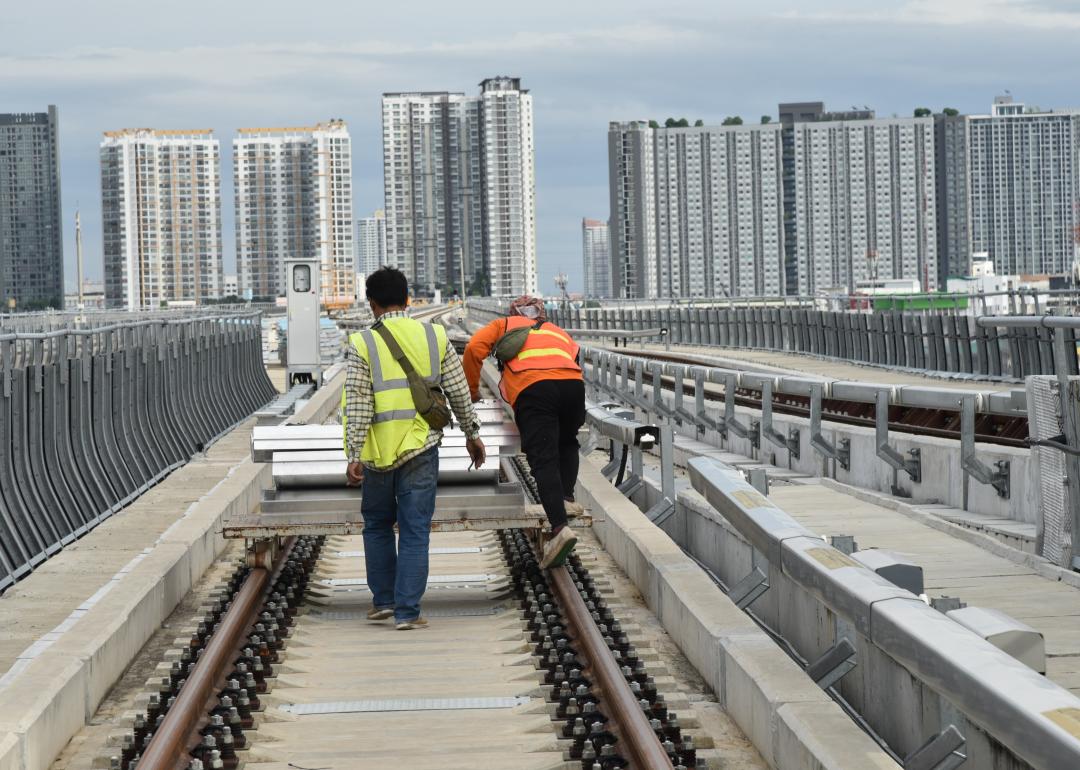
From restoring roads to advancing clean energy: How are states spending federal infrastructure dollars?
This story originally appeared on Truck Parking Club and was produced and distributed in partnership with Stacker Studio.
From restoring roads to advancing clean energy: How are states spending federal infrastructure dollars?
Deadly collapses of structures like Baltimore's Francis Scott Key Bridge and an elevated section of Interstate 95 in Philadelphia are dramatic examples of American infrastructure failures. But millions more Americans are affected daily by dated and deteriorating structures across the country.
Americans make 178 million daily trips across structurally deficient bridges. Up to 10 million American households don't have safe drinking water. More than 30 million Americans live in areas that lack high-speed internet. Climate and extreme weather events have killed nearly 2,000 Americans and caused over $600 billion in damages in just the past five years.
On the whole, U.S. infrastructure is ill-equipped for the demands of modern-day life. In response, the federal government has been pumping money into making repairs and improvements across the country through the Infrastructure Investment and Jobs Act of 2021; the CHIPS and Science Act of 2022, which funds the domestic production of semiconductors and promotes various activities at science agencies; and the Inflation Reduction Act of 2022. Through these, the federal government has announced $582.8 billion in funding toward public infrastructure, semiconductor development, and clean energy across the nation and its territories.
But how do these investments shake out on a local level? Truck Parking Club used White House public investments data to analyze how states are spending federal infrastructure dollars in their communities. This data represents public projects announced as of July that are funded by the Bipartisan Infrastructure Law, Inflation Reduction Act, and CHIPS and Science Act. Projects spanning multiple states were not included in state analyses, but are reflected within national statistics.
Infrastructure encompasses all basic, necessary facilities and systems that service the country's residents. This takes many forms, including roads, power grids, water service, and wireless internet. Much of U.S. infrastructure is aging and overburdened, creating delays, demanding maintenance, and in some cases, posing safety risks.
The inherent issues with safety, security, and the economy led to bipartisan support for the landmark government investments of the 2020s. In all, the Bipartisan Infrastructure Law will invest $1.2 trillion in transportation and infrastructure; the Inflation Reduction Act will invest $369 billion in energy production, manufacturing, and reducing carbon emissions; and the CHIPS and Science Act will invest $52.7 billion to fund in-country semiconductor research, development, and manufacturing through 2027.
Several of the largest projects will give billions to technology corporations to build manufacturing facilities stateside, with an aim to create a domestic supply of semiconductor chips. These small devices are found in many everyday items including computers, smartphones, cars, medical equipment, appliances—nearly any electronic device imaginable. The Department of Commerce has struck deals with Intel, TSMC, Samsung, and Micron to construct and expand these facilities.
Another set of leading investments was the National Clean Investment Fund grants, which provided nearly $14 billion to three green financing institutions. One plans to establish a U.S. national green bank, which will help connect green lenders to fund projects in low-income communities. All three investments are intended to provide affordable loans and other financing for green projects, such as solar installations, homes built with clean technologies, and high-efficiency electrical upgrades.
More than $26 billion has been allocated for projects in "resilience," which refers to efforts to mitigate climate change and other threats. Examples of resilience projects include infrastructure to minimize or prevent damage from flooding or using funds to employ more wildland firefighters.
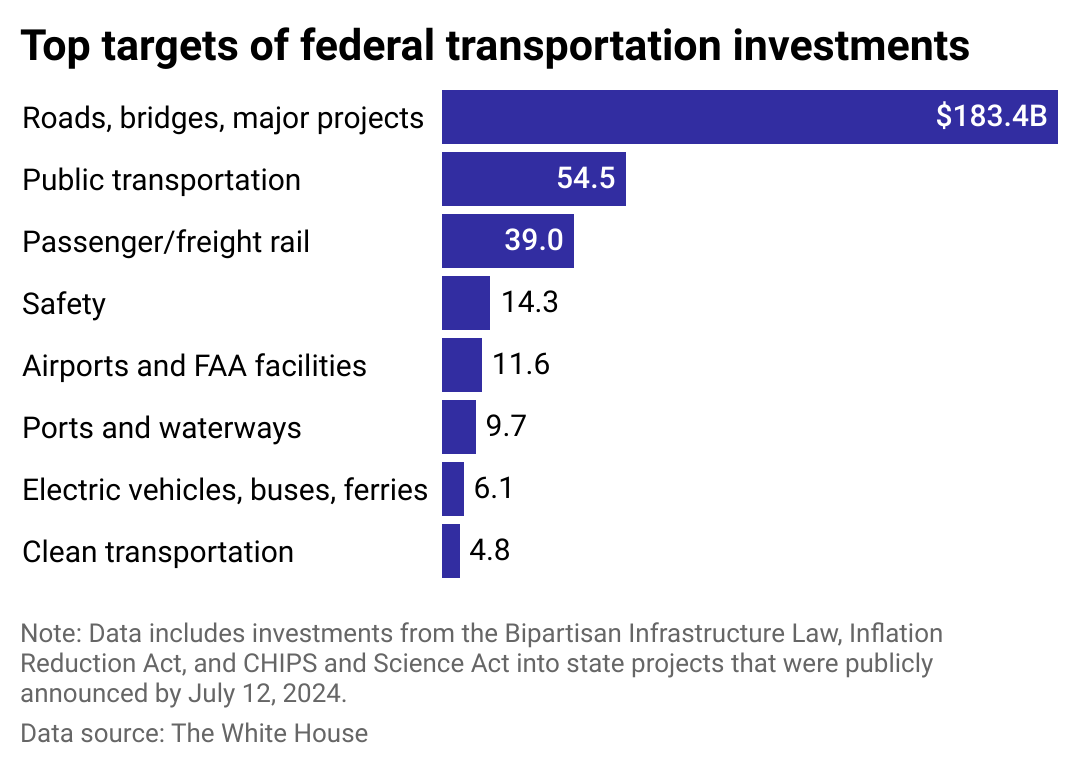
Transportation focus
Transportation projects dominate infrastructure funding allocations, according to the data so far. Just over half of federal dollars announced so far are geared toward transportation. Within the category, most funding has been doled out to build, repair, or modernize roads, bridges, and other major projects.
Some projects hit on several funding targets. For instance, the proposal to replace the bridge connecting Washington and Oregon via I-5 has received $2.1 billion in federal grants, and project planners expect they could receive another $1 billion. Parts of the existing bridge are over 100 years old, and the existing structures are at risk of collapsing in an earthquake. The new bridge is expected to implement new safety features, add auxiliary lanes, and expand public transit and active transportation options.
The Bipartisan Infrastructure Law is also making the largest investment in passenger rail since Amtrak was created. Within the transportation category, the two largest line items in the project database are to build new railroad tunnels in Baltimore and under the Hudson River between New Jersey and New York.
Transportation projects claimed a majority of fund distributions in all but two states, Wyoming and Arizona. In the latter state, the U.S. has said it will provide up to $6.6 billion to TSMC Arizona Corp. to support the development of three advanced semiconductor manufacturing facilities. This is the third-largest project investment that has been announced and the largest to go into a single state. In Wyoming, the other exception, the U.S. is partnering with TerraPower to build a nuclear power plant. The U.S. could invest up to $2 billion in the reactor in its efforts to advance clean energy.
Read on to see how transportation and other federal infrastructure dollars are being allocated in your state. States are listed in alphabetical order, with funds broken down by major categories provided in the White House data.
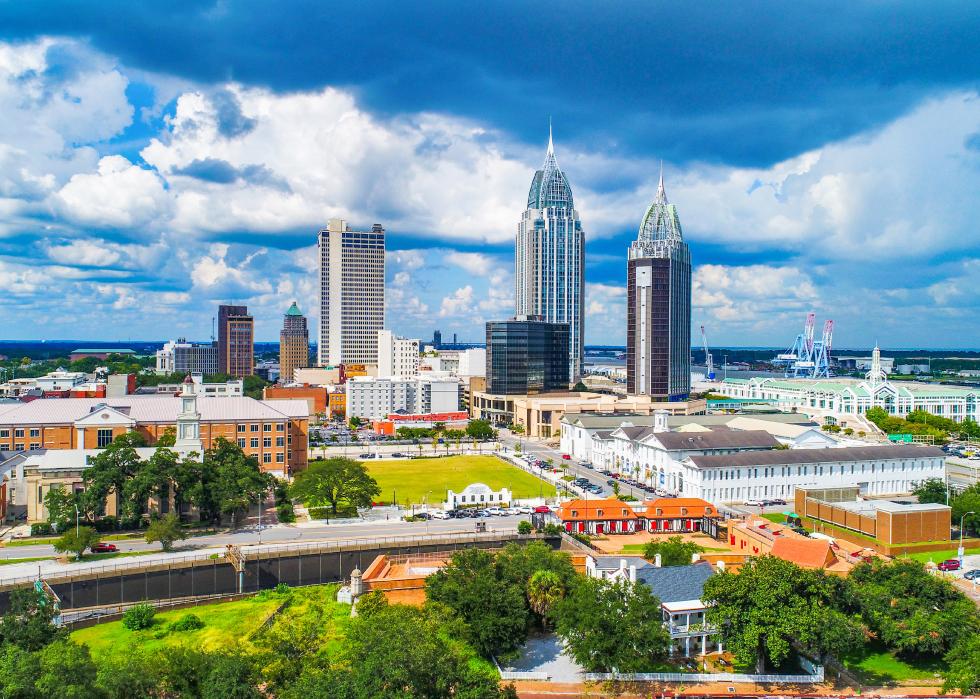
Alabama
The federal government has announced $7.1 billion in funds toward Alabama infrastructure projects. Here's how they break down:
- Transportation: 58.2% (Mostly in roads, bridges, and major projects)
- Clean energy, buildings, and manufacturing: 5.8%
- Broadband internet: 24.2%
- Clean water: 6.3%
- Resilience: 1.8%
- Environmental remediation: 2.5%
- Climate-smart agriculture: 0.5%
- Parks and conservation: 0.2%
- Other: 0.5%
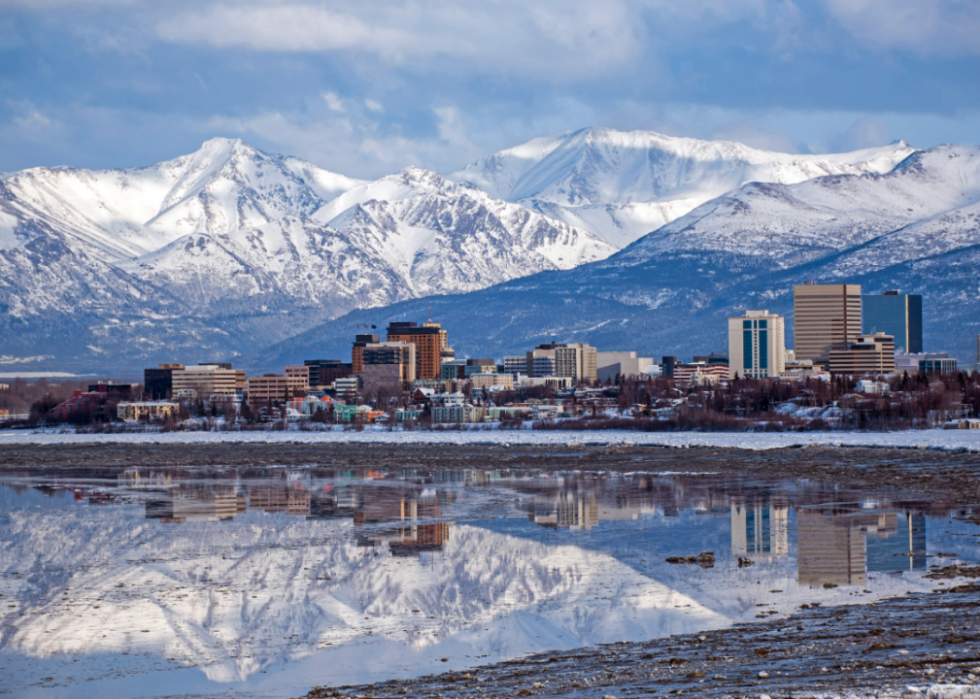
Alaska
The federal government has announced $8.8 billion in funds toward Alaska infrastructure projects. Here's how they break down:
- Transportation: 43.7% (Mostly in roads, bridges, and major projects)
- Clean energy, buildings, and manufacturing: 12.6%
- Broadband internet: 18.0%
- Clean water: 15.4%
- Resilience: 6.9%
- Environmental remediation: 1.3%
- Climate-smart agriculture: 0.0%
- Parks and conservation: 0.4%
- Other: 1.6%
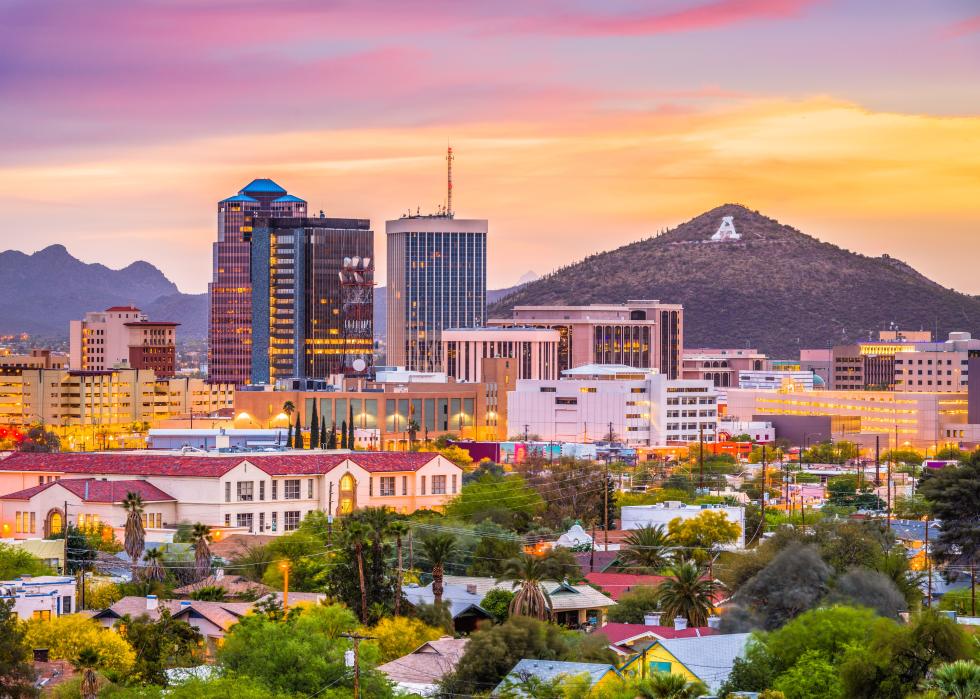
Arizona
The federal government has announced $16.2 billion in funds toward Arizona infrastructure projects. Here's how they break down:
- Transportation: 30.1% (Mostly in roads, bridges, and major projects)
- Clean energy, buildings, and manufacturing: 6.3%
- Broadband internet: 9.1%
- Clean water: 6.9%
- Resilience: 5.4%
- Environmental remediation: 0.9%
- Climate-smart agriculture: 0.1%
- Parks and conservation: 0.3%
- Other: 40.7%
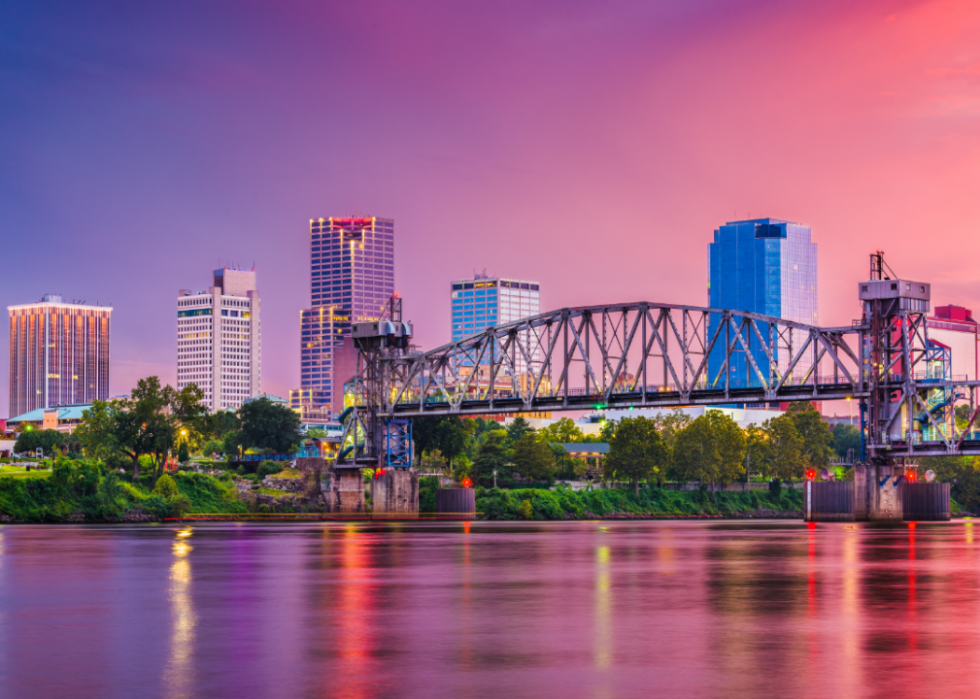
Arkansas
The federal government has announced $5.7 billion in funds toward Arkansas infrastructure projects. Here's how they break down:
- Transportation: 58.6% (Mostly in roads, bridges, and major projects)
- Clean energy, buildings, and manufacturing: 5.1%
- Broadband internet: 21.1%
- Clean water: 5.6%
- Resilience: 7.6%
- Environmental remediation: 0.4%
- Climate-smart agriculture: 1.2%
- Parks and conservation: 0.3%
- Other: 0.2%

California
The federal government has announced $48.2 billion in funds toward California infrastructure projects. Here's how they break down:
- Transportation: 66.0% (Mostly in roads, bridges, and major projects)
- Clean energy, buildings, and manufacturing: 11.1%
- Broadband internet: 7.9%
- Clean water: 7.6%
- Resilience: 5.7%
- Environmental remediation: 0.9%
- Climate-smart agriculture: 0.1%
- Parks and conservation: 0.4%
- Other: 0.2%
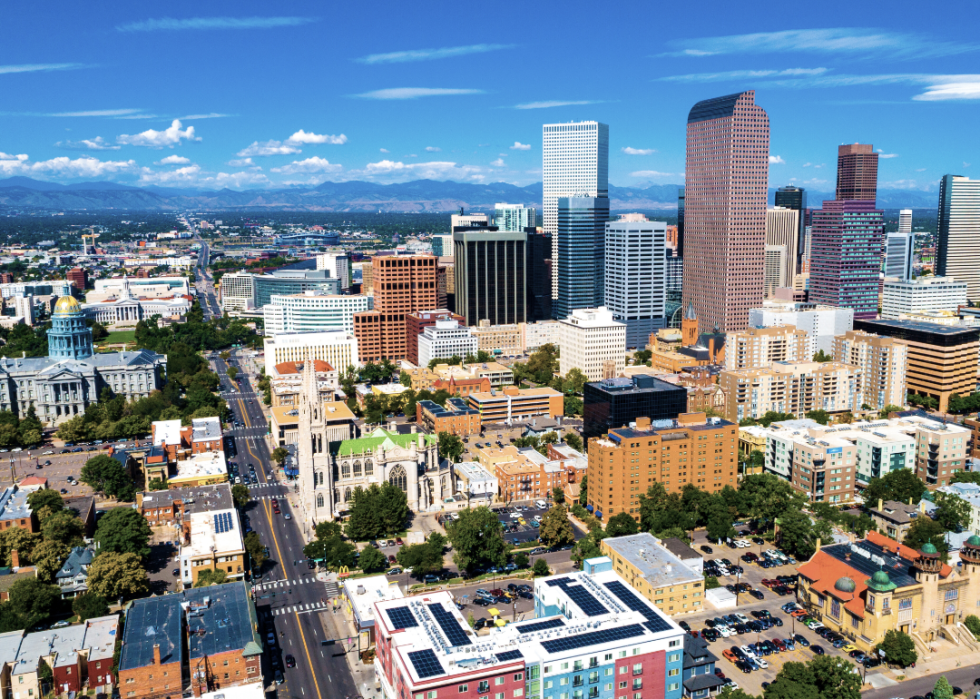
Colorado
The federal government has announced $8.3 billion in funds toward Colorado infrastructure projects. Here's how they break down:
- Transportation: 49.0% (Mostly in roads, bridges, and major projects)
- Clean energy, buildings, and manufacturing: 13.9%
- Broadband internet: 12.8%
- Clean water: 10.6%
- Resilience: 8.1%
- Environmental remediation: 2.7%
- Climate-smart agriculture: 0.1%
- Parks and conservation: 0.6%
- Other: 2.2%
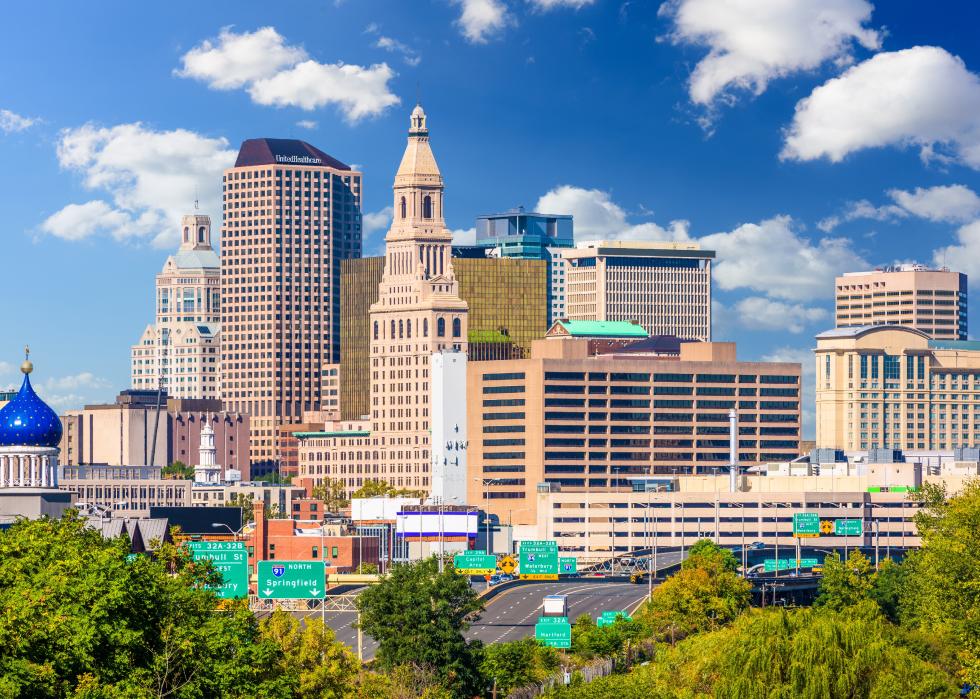
Connecticut
The federal government has announced $7.0 billion in funds toward Connecticut infrastructure projects. Here's how they break down:
- Transportation: 83.4% (Mostly in roads, bridges, and major projects)
- Clean energy, buildings, and manufacturing: 4.7%
- Broadband internet: 3.8%
- Clean water: 4.2%
- Resilience: 1.6%
- Environmental remediation: 1.5%
- Climate-smart agriculture: 0.0%
- Parks and conservation: 0.3%
- Other: 0.4%

Delaware
The federal government has announced $1.7 billion in funds toward Delaware infrastructure projects. Here's how they break down:
- Transportation: 66.6% (Mostly in roads, bridges, and major projects)
- Clean energy, buildings, and manufacturing: 6.5%
- Broadband internet: 8.4%
- Clean water: 13.9%
- Resilience: 3.9%
- Environmental remediation: 0.6%
- Climate-smart agriculture: 0.1%
- Parks and conservation: 0.1%
- Other: 0.1%
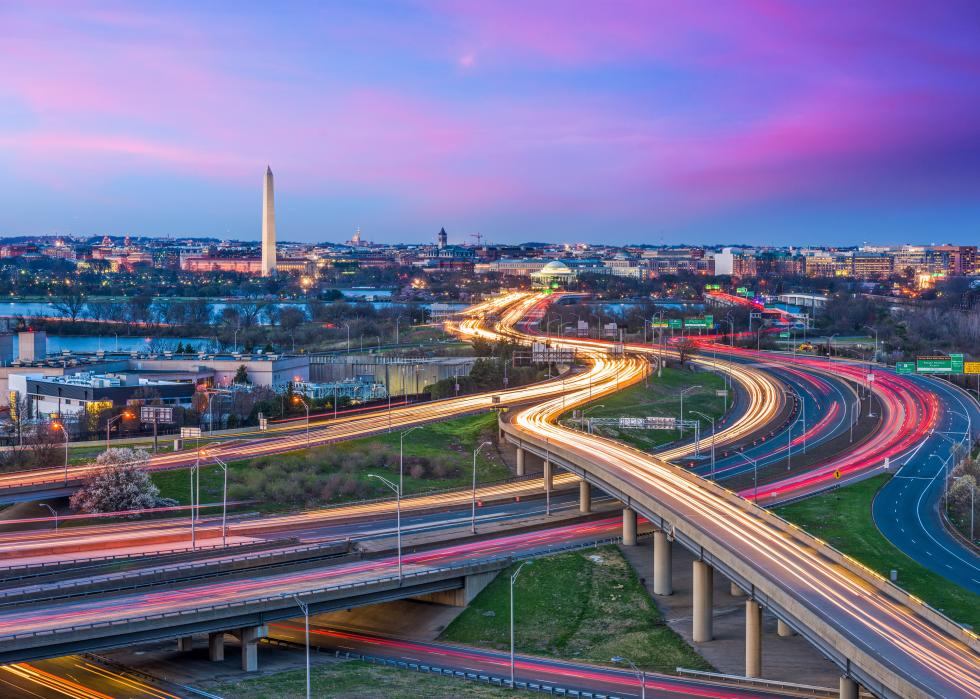
District of Columbia
The federal government has announced $3.1 billion in funds toward District of Columbia infrastructure projects. Here's how they break down:
- Transportation: 64.6% (Mostly in public transportation)
- Clean energy, buildings, and manufacturing: 16.1%
- Broadband internet: 4.9%
- Clean water: 7.8%
- Resilience: 4.8%
- Environmental remediation: 0.3%
- Climate-smart agriculture: 0.0%
- Parks and conservation: 1.4%
- Other: 0.1%
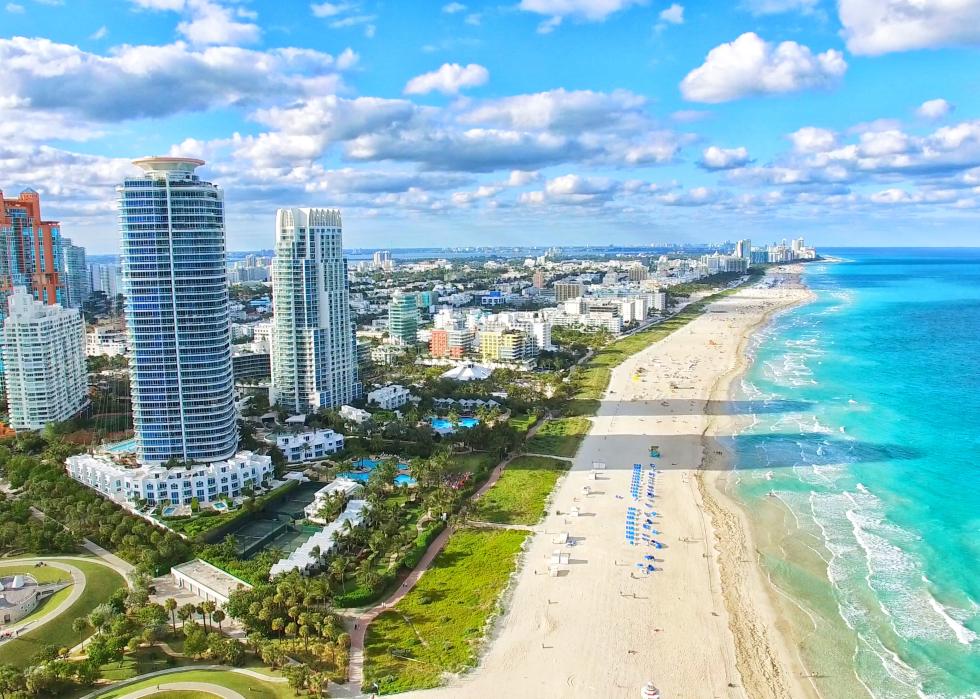
Florida
The federal government has announced $18.4 billion in funds toward Florida infrastructure projects. Here's how they break down:
- Transportation: 64.1% (Mostly in roads, bridges, and major projects)
- Clean energy, buildings, and manufacturing: 5.3%
- Broadband internet: 12.2%
- Clean water: 7.2%
- Resilience: 8.7%
- Environmental remediation: 2.0%
- Climate-smart agriculture: 0.3%
- Parks and conservation: 0.2%
- Other: 0.1%

Georgia
The federal government has announced $11.5 billion in funds toward Georgia infrastructure projects. Here's how they break down:
- Transportation: 63.2% (Mostly in roads, bridges, and major projects)
- Clean energy, buildings, and manufacturing: 9.9%
- Broadband internet: 15.6%
- Clean water: 5.0%
- Resilience: 2.7%
- Environmental remediation: 2.1%
- Climate-smart agriculture: 0.4%
- Parks and conservation: 0.3%
- Other: 0.9%

Hawaii
The federal government has announced $2.9 billion in funds toward Hawaii infrastructure projects. Here's how they break down:
- Transportation: 65.0% (Mostly in roads, bridges, and major projects)
- Clean energy, buildings, and manufacturing: 10.4%
- Broadband internet: 8.5%
- Clean water: 9.4%
- Resilience: 3.3%
- Environmental remediation: 0.4%
- Climate-smart agriculture: 0.2%
- Parks and conservation: 2.4%
- Other: 0.3%

Idaho
The federal government has announced $3.4 billion in funds toward Idaho infrastructure projects. Here's how they break down:
- Transportation: 50.2% (Mostly in roads, bridges, and major projects)
- Clean energy, buildings, and manufacturing: 10.2%
- Broadband internet: 18.8%
- Clean water: 9.4%
- Resilience: 8.6%
- Environmental remediation: 0.6%
- Climate-smart agriculture: 0.2%
- Parks and conservation: 1.4%
- Other: 0.6%
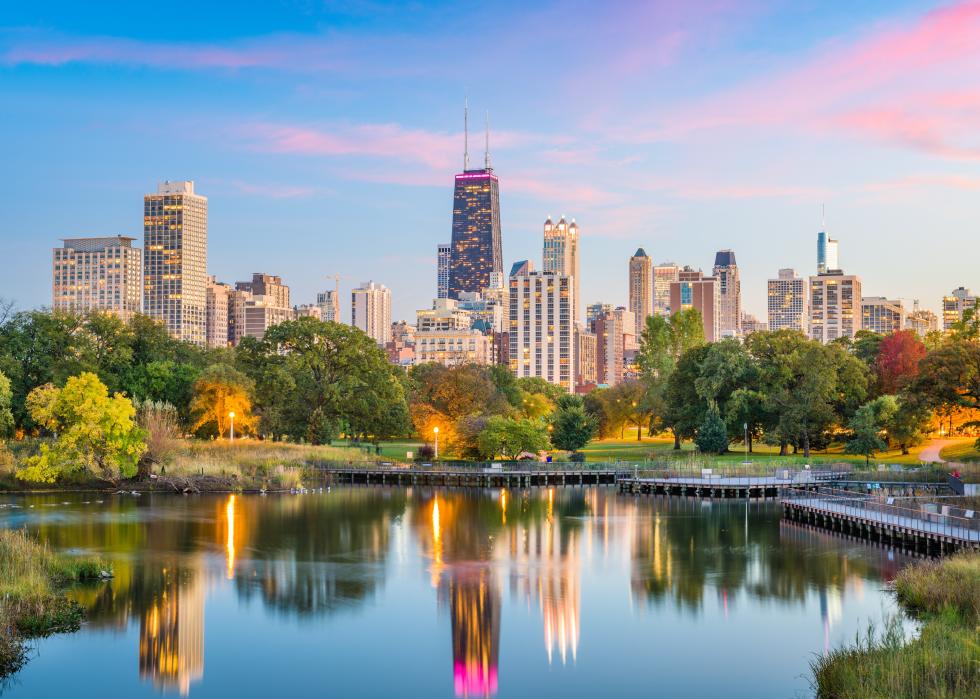
Illinois
The federal government has announced $18.2 billion in funds toward Illinois infrastructure projects. Here's how they break down:
- Transportation: 66.5% (Mostly in roads, bridges, and major projects)
- Clean energy, buildings, and manufacturing: 6.7%
- Broadband internet: 8.6%
- Clean water: 7.1%
- Resilience: 8.1%
- Environmental remediation: 2.5%
- Climate-smart agriculture: 0.3%
- Parks and conservation: 0.2%
- Other: 0.1%
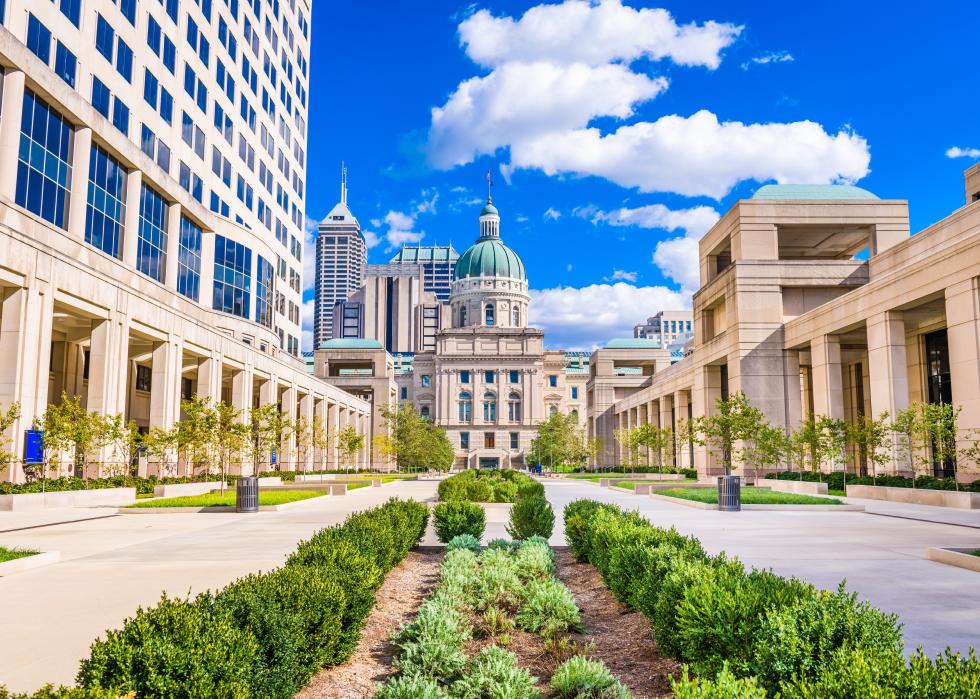
Indiana
The federal government has announced $8.3 billion in funds toward Indiana infrastructure projects. Here's how they break down:
- Transportation: 62.4% (Mostly in roads, bridges, and major projects)
- Clean energy, buildings, and manufacturing: 12.5%
- Broadband internet: 13.8%
- Clean water: 7.0%
- Resilience: 1.6%
- Environmental remediation: 1.8%
- Climate-smart agriculture: 0.4%
- Parks and conservation: 0.4%
- Other: 0.1%
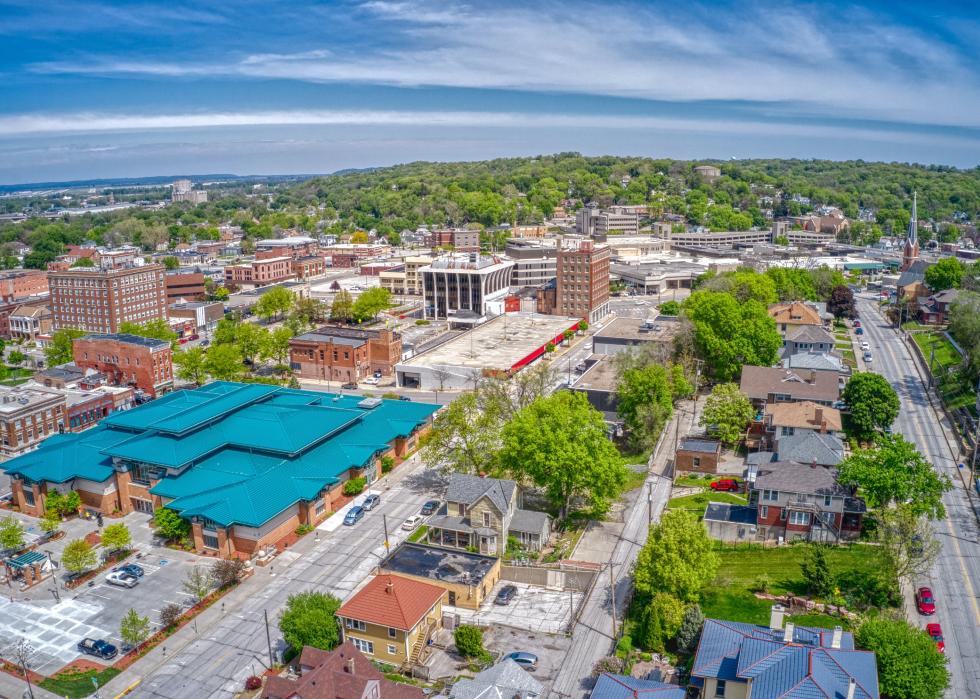
Iowa
The federal government has announced $4.8 billion in funds toward Iowa infrastructure projects. Here's how they break down:
- Transportation: 68.7% (Mostly in roads, bridges, and major projects)
- Clean energy, buildings, and manufacturing: 5.8%
- Broadband internet: 11.2%
- Clean water: 7.6%
- Resilience: 4.0%
- Environmental remediation: 0.9%
- Climate-smart agriculture: 1.2%
- Parks and conservation: 0.4%
- Other: 0.2%
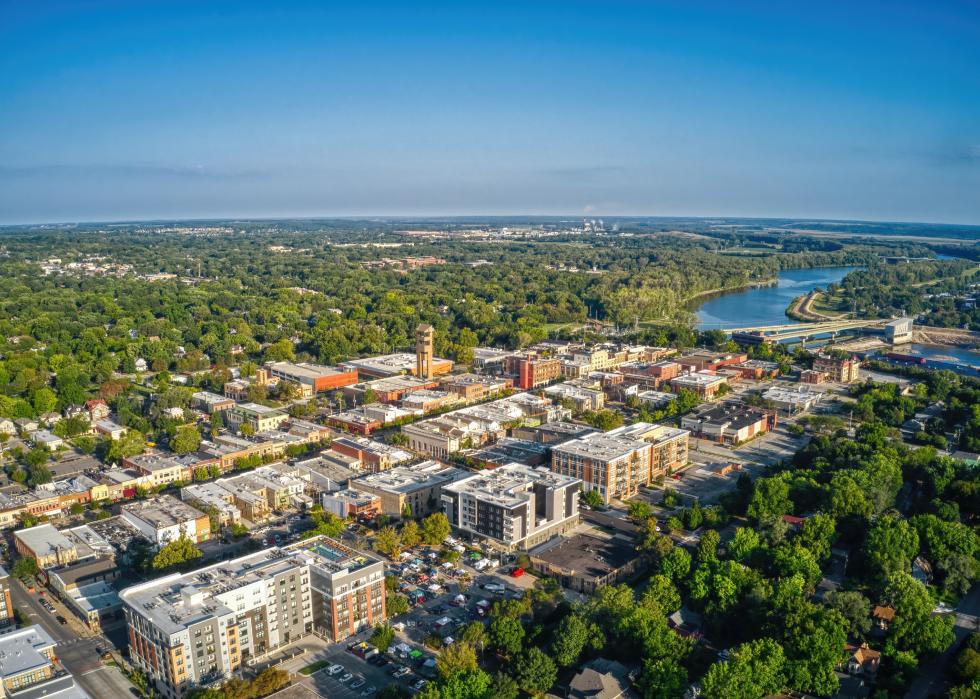
Kansas
The federal government has announced $3.7 billion in funds toward Kansas infrastructure projects. Here's how they break down:
- Transportation: 59.0% (Mostly in roads, bridges, and major projects)
- Clean energy, buildings, and manufacturing: 10.1%
- Broadband internet: 15.9%
- Clean water: 8.5%
- Resilience: 2.6%
- Environmental remediation: 2.8%
- Climate-smart agriculture: 1.0%
- Parks and conservation: 0.1%
- Other: 0.1%
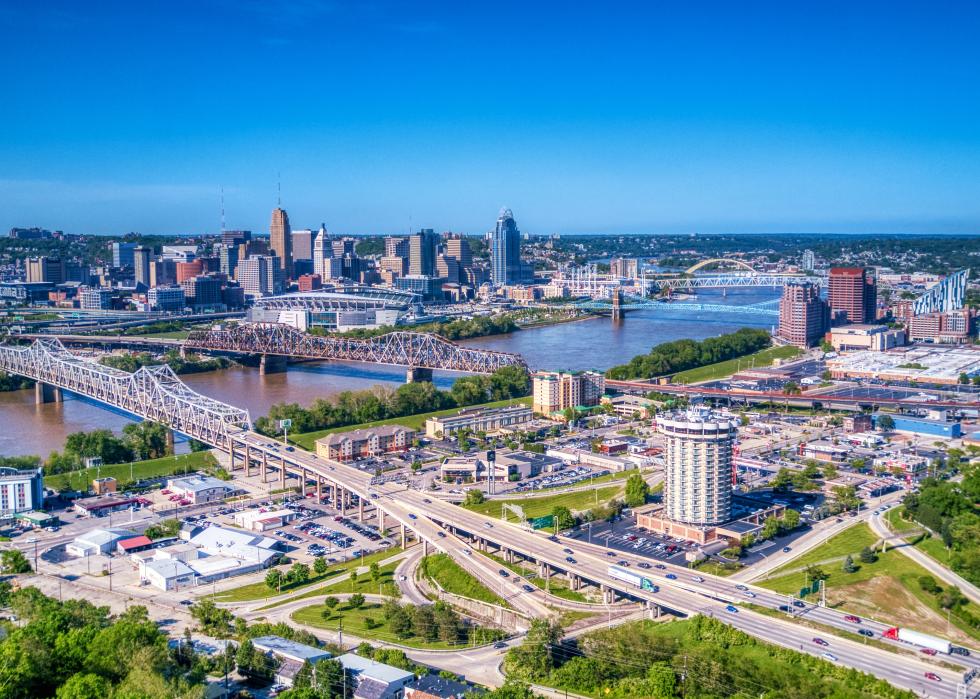
Kentucky
The federal government has announced $8.1 billion in funds toward Kentucky infrastructure projects. Here's how they break down:
- Transportation: 48.7% (Mostly in roads, bridges, and major projects)
- Clean energy, buildings, and manufacturing: 15.9%
- Broadband internet: 17.4%
- Clean water: 4.3%
- Resilience: 7.5%
- Environmental remediation: 5.0%
- Climate-smart agriculture: 0.4%
- Parks and conservation: 0.2%
- Other: 0.7%
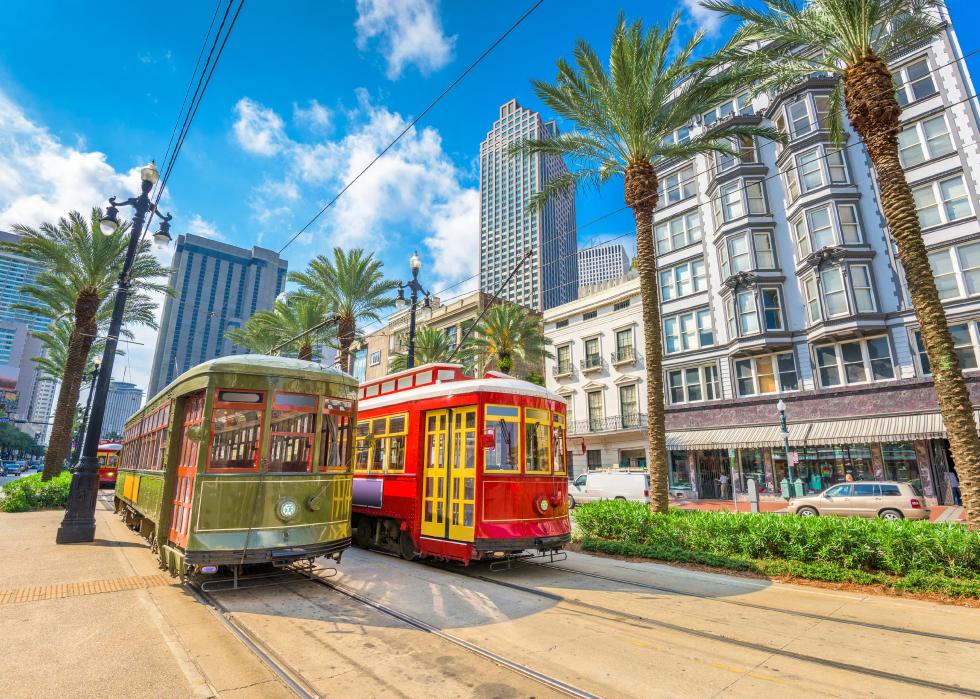
Louisiana
The federal government has announced $9.5 billion in funds toward Louisiana infrastructure projects. Here's how they break down:
- Transportation: 57.6% (Mostly in roads, bridges, and major projects)
- Clean energy, buildings, and manufacturing: 10.7%
- Broadband internet: 18.0%
- Clean water: 4.3%
- Resilience: 6.7%
- Environmental remediation: 2.0%
- Climate-smart agriculture: 0.1%
- Parks and conservation: 0.3%
- Other: 0.3%
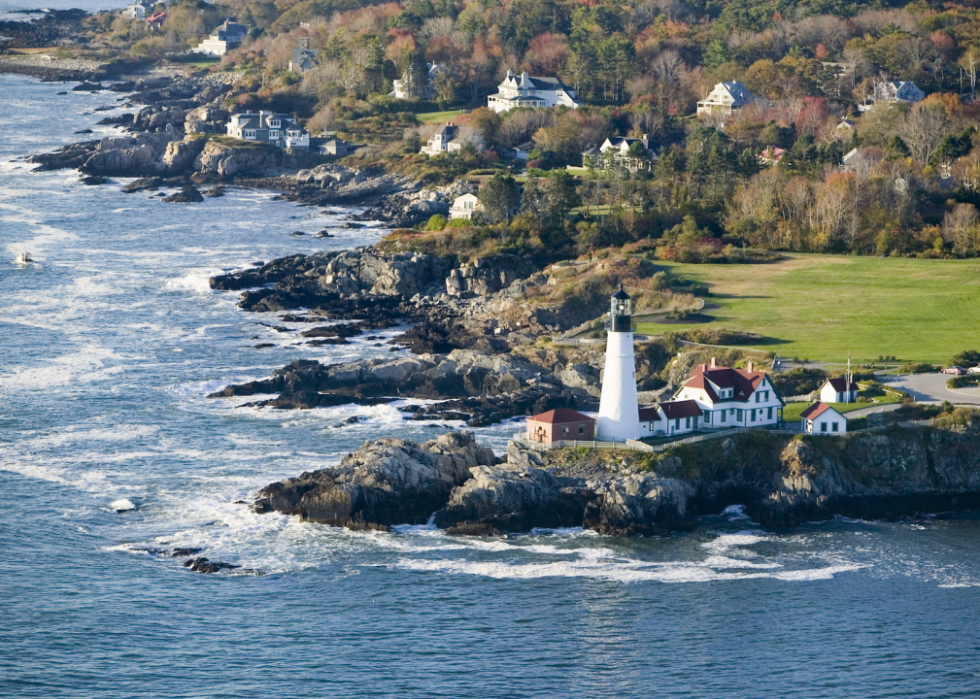
Maine
The federal government has announced $2.8 billion in funds toward Maine infrastructure projects. Here's how they break down:
- Transportation: 54.7% (Mostly in roads, bridges, and major projects)
- Clean energy, buildings, and manufacturing: 11.6%
- Broadband internet: 13.2%
- Clean water: 9.5%
- Resilience: 2.7%
- Environmental remediation: 4.3%
- Climate-smart agriculture: 0.1%
- Parks and conservation: 0.1%
- Other: 3.9%
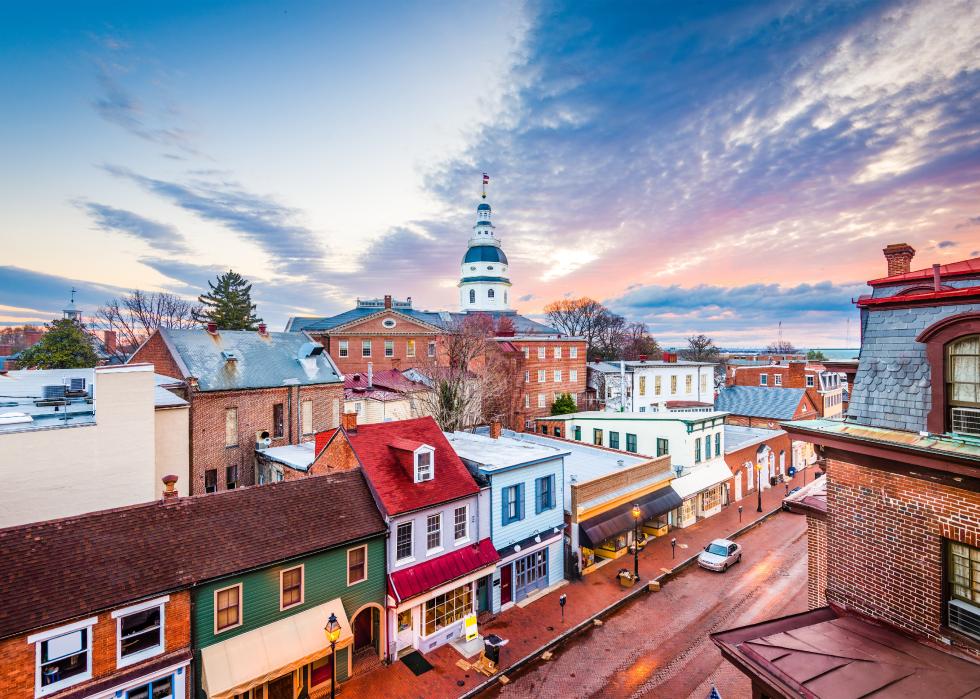
Maryland
The federal government has announced $13.3 billion in funds toward Maryland infrastructure projects. Here's how they break down:
- Transportation: 86.9% (Mostly in passenger and freight rail)
- Clean energy, buildings, and manufacturing: 2.9%
- Broadband internet: 3.5%
- Clean water: 3.6%
- Resilience: 1.7%
- Environmental remediation: 0.7%
- Climate-smart agriculture: 0.3%
- Parks and conservation: 0.3%
- Other: 0.2%

Massachusetts
The federal government has announced $8.9 billion in funds toward Massachusetts infrastructure projects. Here's how they break down:
- Transportation: 71.5% (Mostly in roads, bridges, and major projects)
- Clean energy, buildings, and manufacturing: 8.7%
- Broadband internet: 4.3%
- Clean water: 7.0%
- Resilience: 1.6%
- Environmental remediation: 5.9%
- Climate-smart agriculture: 0.0%
- Parks and conservation: 0.5%
- Other: 0.3%
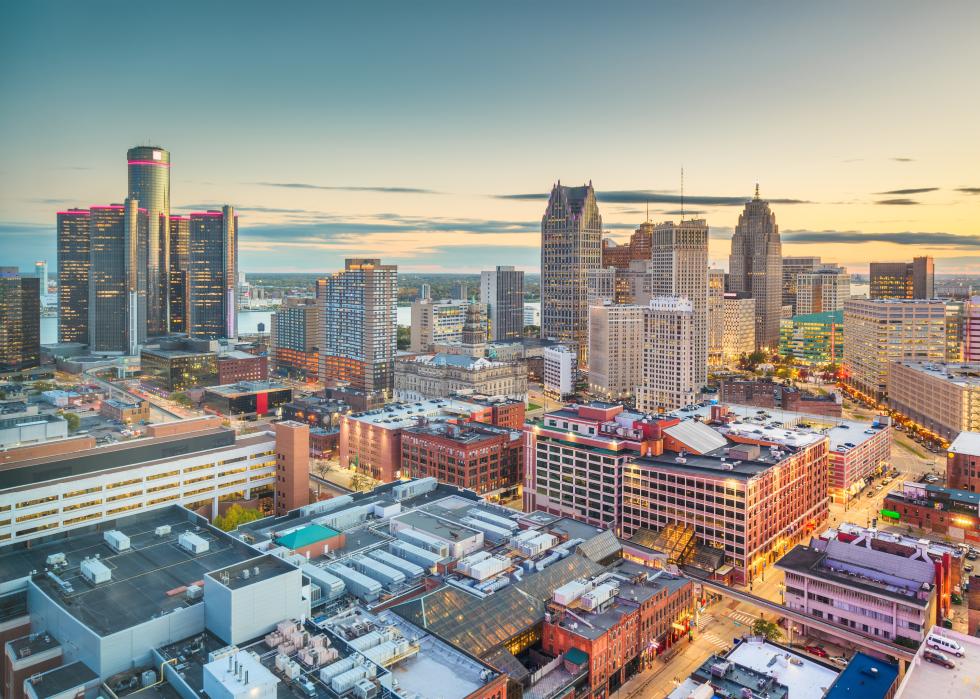
Michigan
The federal government has announced $12.3 billion in funds toward Michigan infrastructure projects. Here's how they break down:
- Transportation: 63.3% (Mostly in roads, bridges, and major projects)
- Clean energy, buildings, and manufacturing: 8.1%
- Broadband internet: 18.3%
- Clean water: 6.4%
- Resilience: 2.4%
- Environmental remediation: 0.7%
- Climate-smart agriculture: 0.3%
- Parks and conservation: 0.4%
- Other: 0.2%
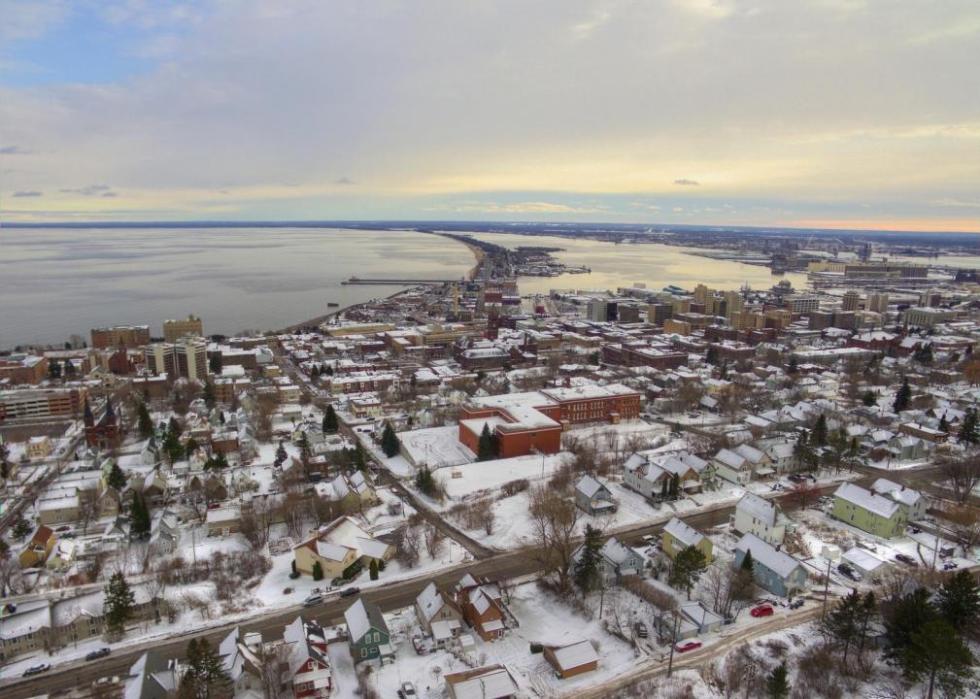
Minnesota
The federal government has announced $7.5 billion in funds toward Minnesota infrastructure projects. Here's how they break down:
- Transportation: 61.9% (Mostly in roads, bridges, and major projects)
- Clean energy, buildings, and manufacturing: 13.0%
- Broadband internet: 11.8%
- Clean water: 7.7%
- Resilience: 1.8%
- Environmental remediation: 1.0%
- Climate-smart agriculture: 0.5%
- Parks and conservation: 0.5%
- Other: 1.8%
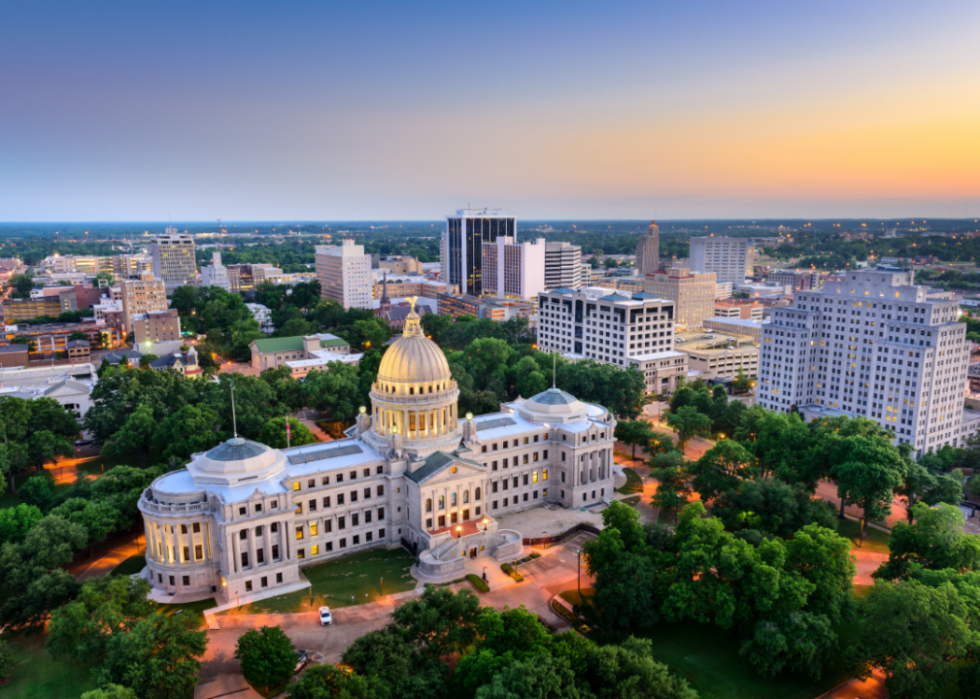
Mississippi
The federal government has announced $5.5 billion in funds toward Mississippi infrastructure projects. Here's how they break down:
- Transportation: 49.8% (Mostly in roads, bridges, and major projects)
- Clean energy, buildings, and manufacturing: 6.4%
- Broadband internet: 26.0%
- Clean water: 5.3%
- Resilience: 9.4%
- Environmental remediation: 1.3%
- Climate-smart agriculture: 0.7%
- Parks and conservation: 0.5%
- Other: 0.7%

Missouri
The federal government has announced $9.3 billion in funds toward Missouri infrastructure projects. Here's how they break down:
- Transportation: 57.5% (Mostly in roads, bridges, and major projects)
- Clean energy, buildings, and manufacturing: 9.5%
- Broadband internet: 23.2%
- Clean water: 5.5%
- Resilience: 2.1%
- Environmental remediation: 1.5%
- Climate-smart agriculture: 0.2%
- Parks and conservation: 0.2%
- Other: 0.2%
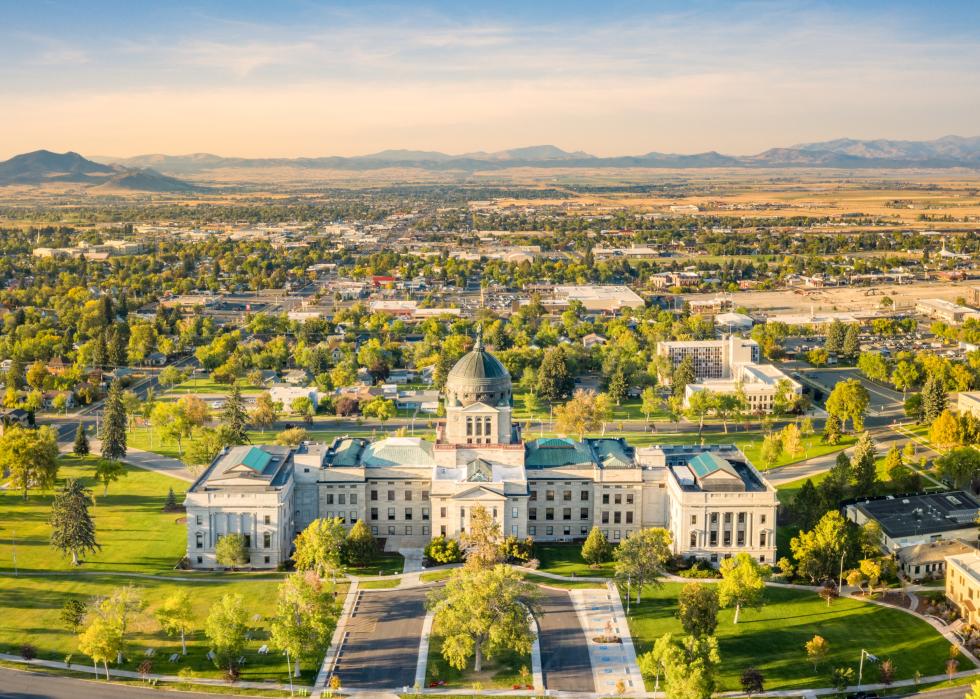
Montana
The federal government has announced $6.1 billion in funds toward Montana infrastructure projects. Here's how they break down:
- Transportation: 41.0% (Mostly in roads, bridges, and major projects)
- Clean energy, buildings, and manufacturing: 3.6%
- Broadband internet: 12.8%
- Clean water: 33.6%
- Resilience: 4.8%
- Environmental remediation: 3.0%
- Climate-smart agriculture: 0.4%
- Parks and conservation: 0.6%
- Other: 0.2%
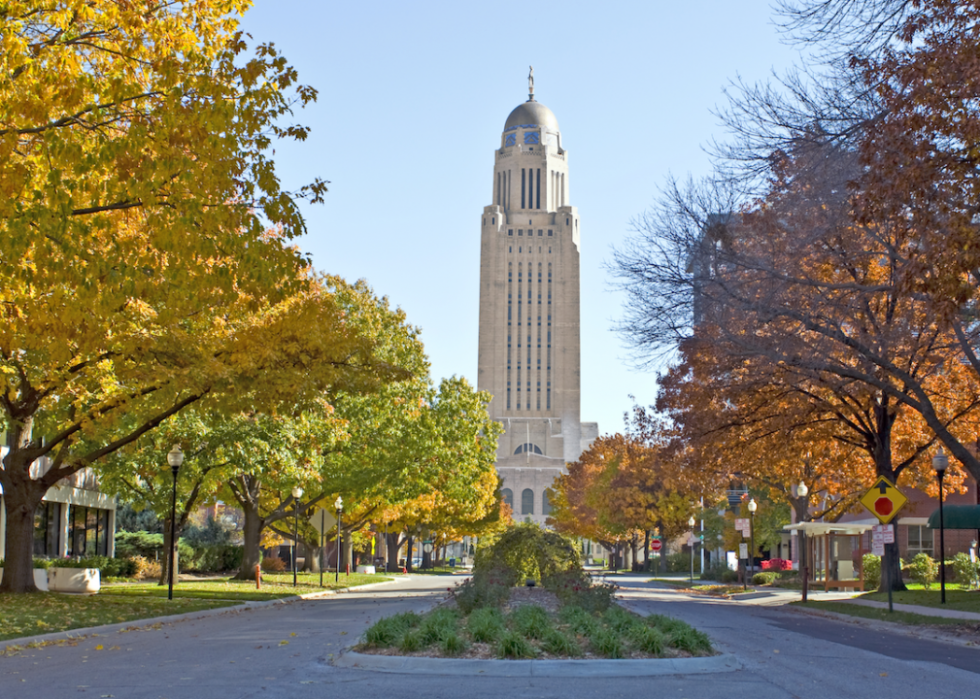
Nebraska
The federal government has announced $3.0 billion in funds toward Nebraska infrastructure projects. Here's how they break down:
- Transportation: 57.1% (Mostly in roads, bridges, and major projects)
- Clean energy, buildings, and manufacturing: 9.5%
- Broadband internet: 17.1%
- Clean water: 8.8%
- Resilience: 4.1%
- Environmental remediation: 2.2%
- Climate-smart agriculture: 0.5%
- Parks and conservation: 0.8%
- Other: 0.1%
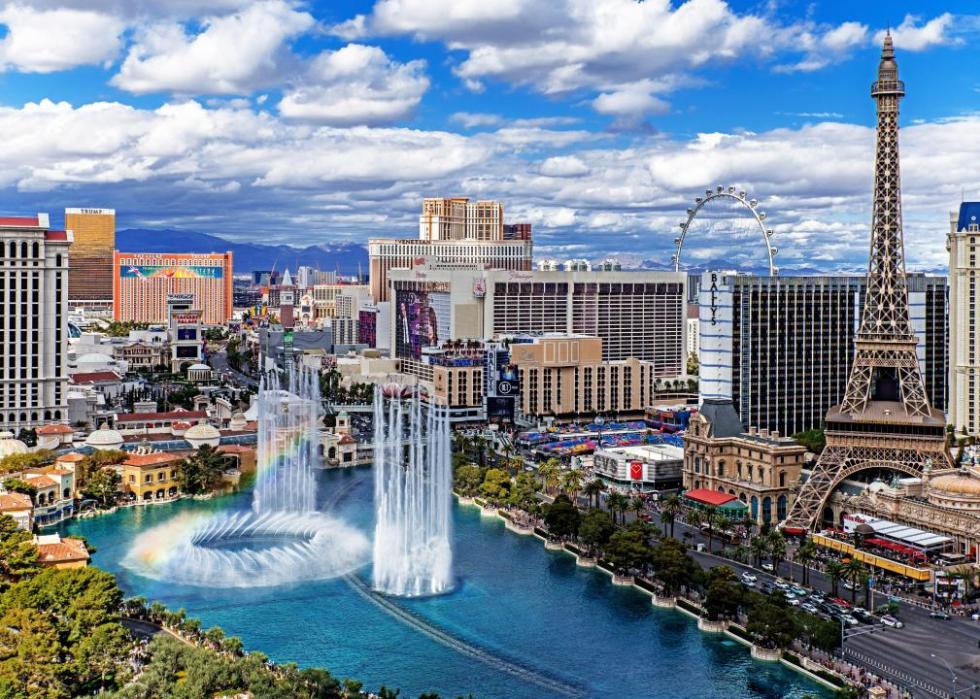
Nevada
The federal government has announced $4.2 billion in funds toward Nevada infrastructure projects. Here's how they break down:
- Transportation: 59.9% (Mostly in roads, bridges, and major projects)
- Clean energy, buildings, and manufacturing: 9.1%
- Broadband internet: 15.7%
- Clean water: 7.7%
- Resilience: 3.3%
- Environmental remediation: 3.4%
- Climate-smart agriculture: 0.0%
- Parks and conservation: 0.7%
- Other: 0.1%
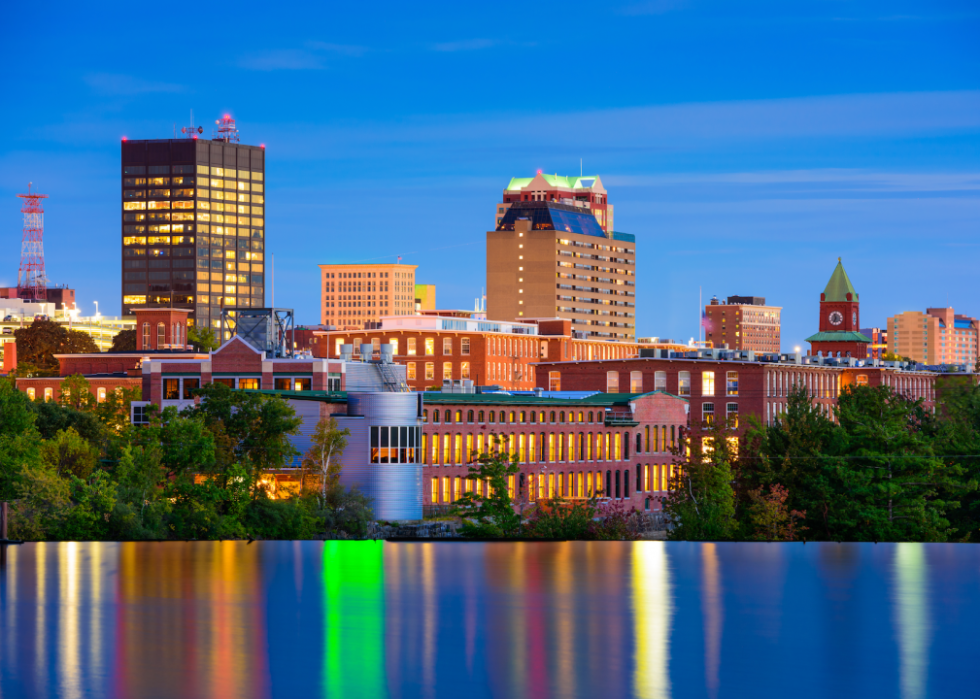
New Hampshire
The federal government has announced $1.9 billion in funds toward New Hampshire infrastructure projects. Here's how they break down:
- Transportation: 54.0% (Mostly in roads, bridges, and major projects)
- Clean energy, buildings, and manufacturing: 8.3%
- Broadband internet: 12.4%
- Clean water: 18.1%
- Resilience: 3.7%
- Environmental remediation: 0.9%
- Climate-smart agriculture: 0.1%
- Parks and conservation: 0.2%
- Other: 2.3%

New Jersey
The federal government has announced $12.3 billion in funds toward New Jersey infrastructure projects. Here's how they break down:
- Transportation: 77.3% (Mostly in roads, bridges, and major projects)
- Clean energy, buildings, and manufacturing: 4.5%
- Broadband internet: 3.9%
- Clean water: 6.3%
- Resilience: 4.2%
- Environmental remediation: 3.3%
- Climate-smart agriculture: 0.0%
- Parks and conservation: 0.3%
- Other: 0.2%
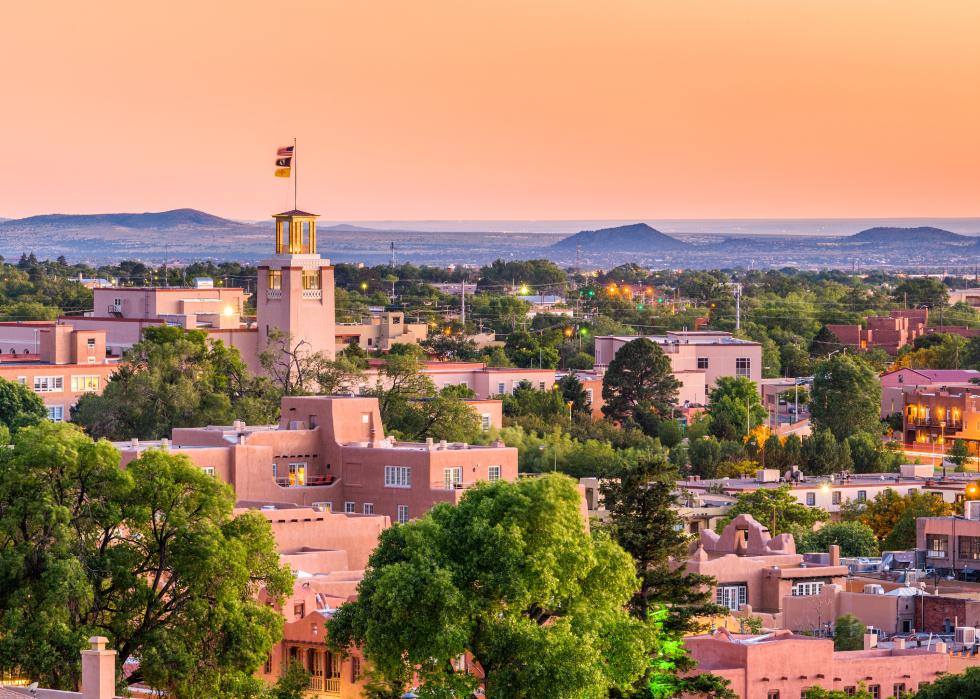
New Mexico
The federal government has announced $5.8 billion in funds toward New Mexico infrastructure projects. Here's how they break down:
- Transportation: 40.9% (Mostly in roads, bridges, and major projects)
- Clean energy, buildings, and manufacturing: 8.2%
- Broadband internet: 18.9%
- Clean water: 21.3%
- Resilience: 7.7%
- Environmental remediation: 1.6%
- Climate-smart agriculture: 0.2%
- Parks and conservation: 0.6%
- Other: 0.5%
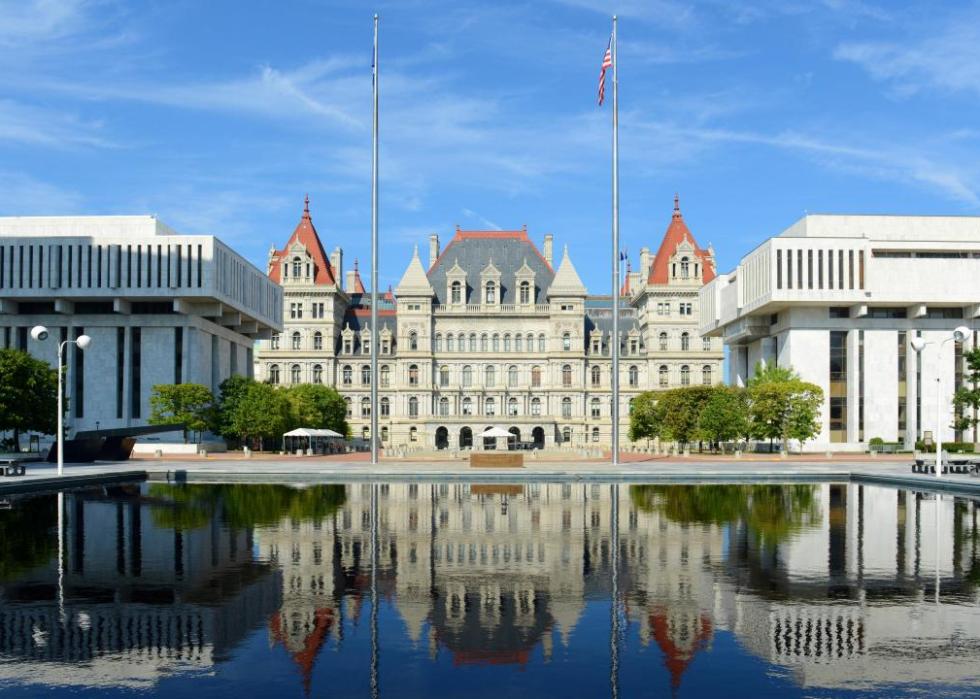
New York
The federal government has announced $28.2 billion in funds toward New York infrastructure projects. Here's how they break down:
- Transportation: 72.7% (Mostly in roads, bridges, and major projects)
- Clean energy, buildings, and manufacturing: 5.6%
- Broadband internet: 6.2%
- Clean water: 6.0%
- Resilience: 1.8%
- Environmental remediation: 2.3%
- Climate-smart agriculture: 0.0%
- Parks and conservation: 0.3%
- Other: 5.0%

North Carolina
The federal government has announced $10.3 billion in funds toward North Carolina infrastructure projects. Here's how they break down:
- Transportation: 60.7% (Mostly in roads, bridges, and major projects)
- Clean energy, buildings, and manufacturing: 6.4%
- Broadband internet: 21.2%
- Clean water: 6.9%
- Resilience: 2.2%
- Environmental remediation: 1.4%
- Climate-smart agriculture: 0.2%
- Parks and conservation: 0.5%
- Other: 0.6%
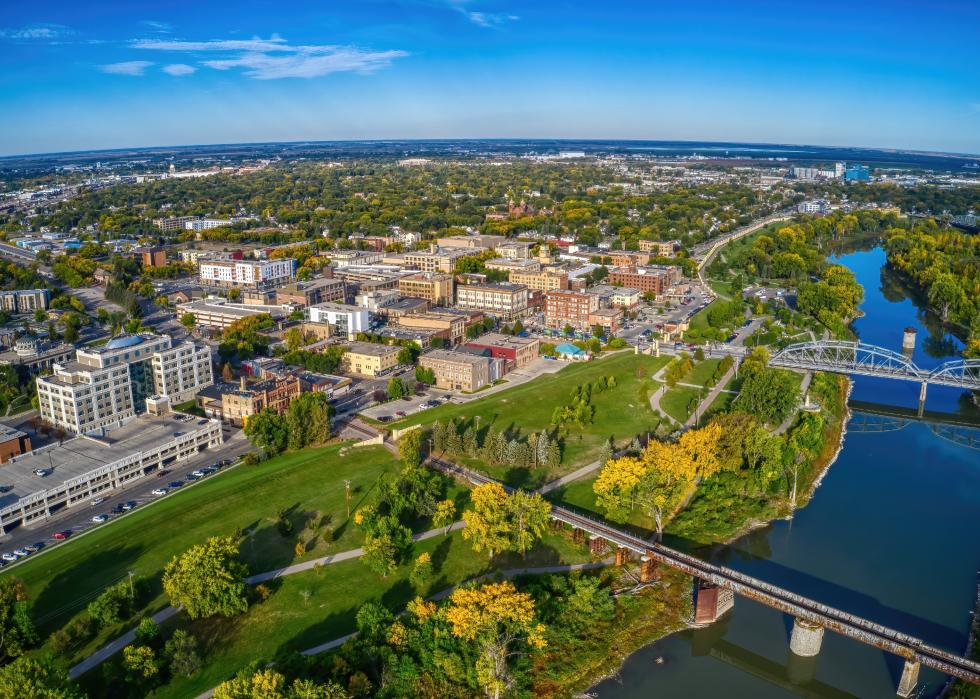
North Dakota
The federal government has announced $3.7 billion in funds toward North Dakota infrastructure projects. Here's how they break down:
- Transportation: 40.4% (Mostly in roads, bridges, and major projects)
- Clean energy, buildings, and manufacturing: 23.3%
- Broadband internet: 4.7%
- Clean water: 13.0%
- Resilience: 16.2%
- Environmental remediation: 1.9%
- Climate-smart agriculture: 0.3%
- Parks and conservation: 0.0%
- Other: 0.2%

Ohio
The federal government has announced $13.8 billion in funds toward Ohio infrastructure projects. Here's how they break down:
- Transportation: 65.1% (Mostly in roads, bridges, and major projects)
- Clean energy, buildings, and manufacturing: 10.6%
- Broadband internet: 11.5%
- Clean water: 8.7%
- Resilience: 1.5%
- Environmental remediation: 2.0%
- Climate-smart agriculture: 0.0%
- Parks and conservation: 0.2%
- Other: 0.2%

Oklahoma
The federal government has announced $6.4 billion in funds toward Oklahoma infrastructure projects. Here's how they break down:
- Transportation: 57.4% (Mostly in roads, bridges, and major projects)
- Clean energy, buildings, and manufacturing: 5.8%
- Broadband internet: 22.8%
- Clean water: 7.6%
- Resilience: 3.1%
- Environmental remediation: 3.1%
- Climate-smart agriculture: 0.1%
- Parks and conservation: 0.1%
- Other: 0.0%
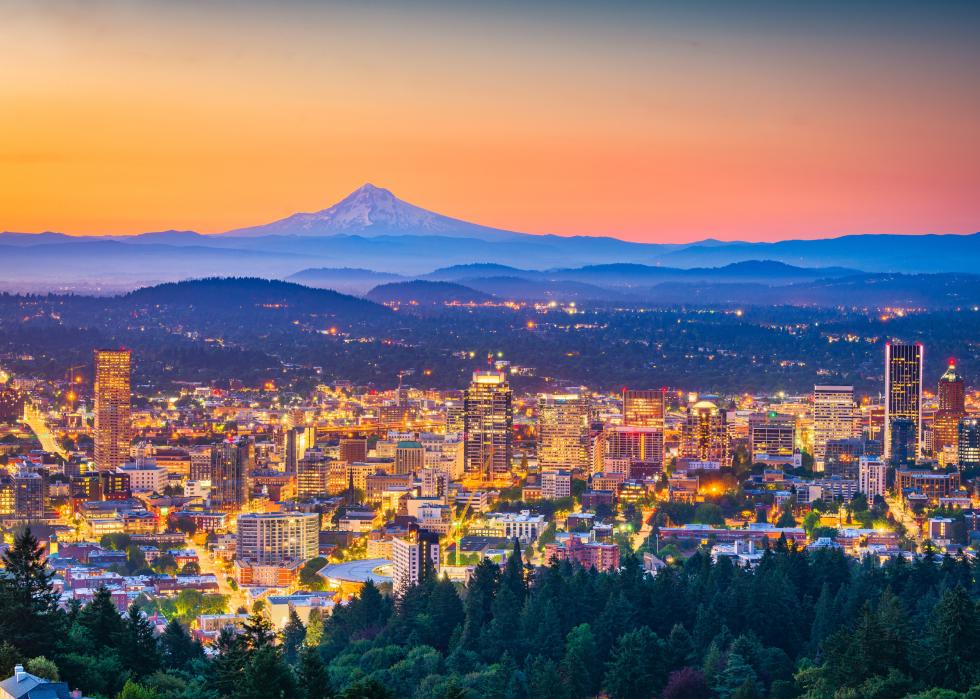
Oregon
The federal government has announced $6.5 billion in funds toward Oregon infrastructure projects. Here's how they break down:
- Transportation: 52.2% (Mostly in roads, bridges, and major projects)
- Clean energy, buildings, and manufacturing: 9.8%
- Broadband internet: 13.7%
- Clean water: 6.9%
- Resilience: 4.9%
- Environmental remediation: 8.5%
- Climate-smart agriculture: 0.3%
- Parks and conservation: 1.3%
- Other: 2.5%
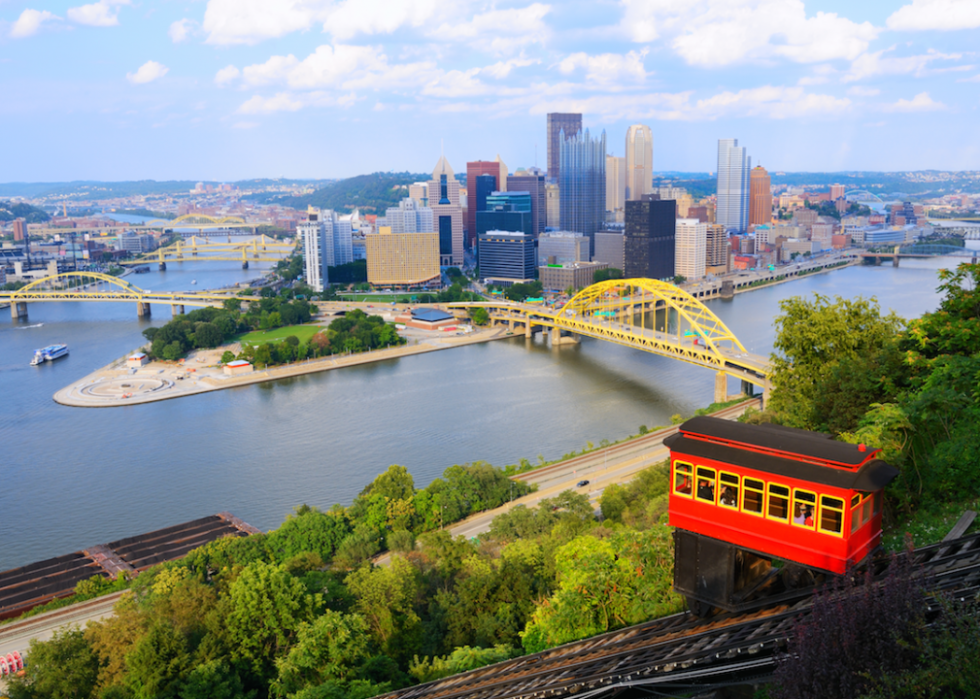
Pennsylvania
The federal government has announced $18.1 billion in funds toward Pennsylvania infrastructure projects. Here's how they break down:
- Transportation: 65.0% (Mostly in roads, bridges, and major projects)
- Clean energy, buildings, and manufacturing: 6.1%
- Broadband internet: 9.0%
- Clean water: 5.8%
- Resilience: 6.8%
- Environmental remediation: 6.6%
- Climate-smart agriculture: 0.1%
- Parks and conservation: 0.2%
- Other: 0.2%

Rhode Island
The federal government has announced $2.5 billion in funds toward Rhode Island infrastructure projects. Here's how they break down:
- Transportation: 62.1% (Mostly in roads, bridges, and major projects)
- Clean energy, buildings, and manufacturing: 8.2%
- Broadband internet: 6.4%
- Clean water: 12.0%
- Resilience: 5.9%
- Environmental remediation: 0.5%
- Climate-smart agriculture: 0.0%
- Parks and conservation: 4.3%
- Other: 0.7%
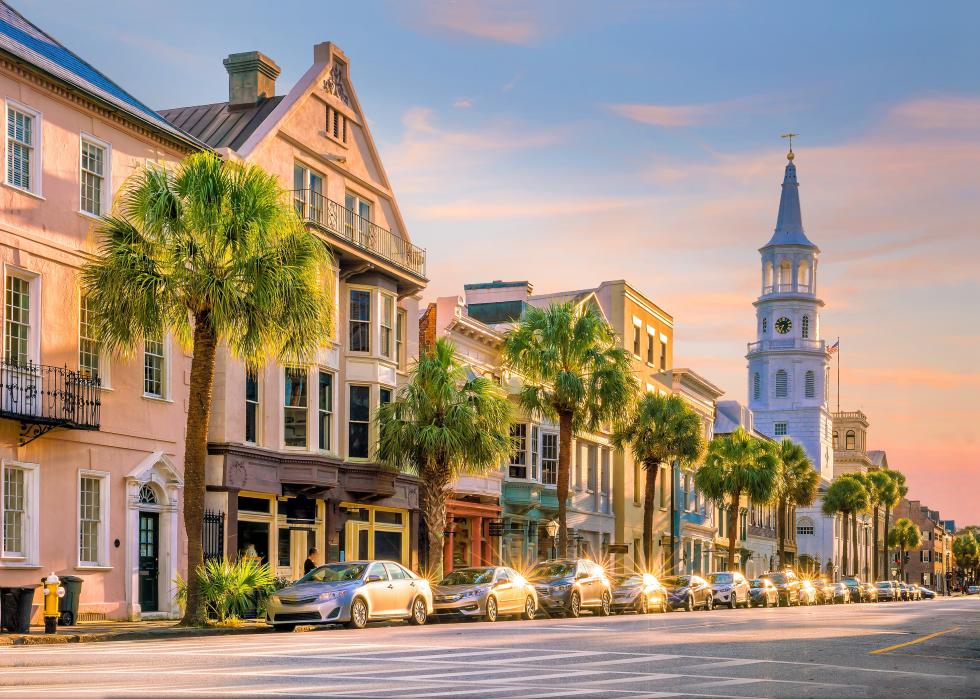
South Carolina
The federal government has announced $5.5 billion in funds toward South Carolina infrastructure projects. Here's how they break down:
- Transportation: 65.6% (Mostly in roads, bridges, and major projects)
- Clean energy, buildings, and manufacturing: 8.3%
- Broadband internet: 15.5%
- Clean water: 5.8%
- Resilience: 2.4%
- Environmental remediation: 0.5%
- Climate-smart agriculture: 0.1%
- Parks and conservation: 1.3%
- Other: 0.4%
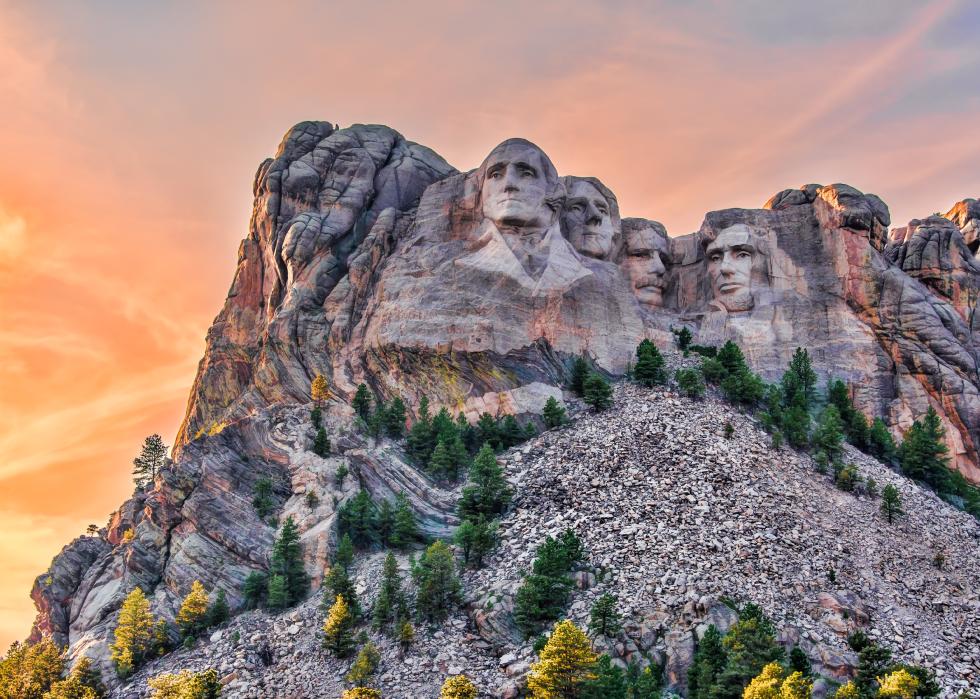
South Dakota
The federal government has announced $3.0 billion in funds toward South Dakota infrastructure projects. Here's how they break down:
- Transportation: 57.2% (Mostly in roads, bridges, and major projects)
- Clean energy, buildings, and manufacturing: 5.0%
- Broadband internet: 8.5%
- Clean water: 21.3%
- Resilience: 4.9%
- Environmental remediation: 0.3%
- Climate-smart agriculture: 2.5%
- Parks and conservation: 0.2%
- Other: 0.1%
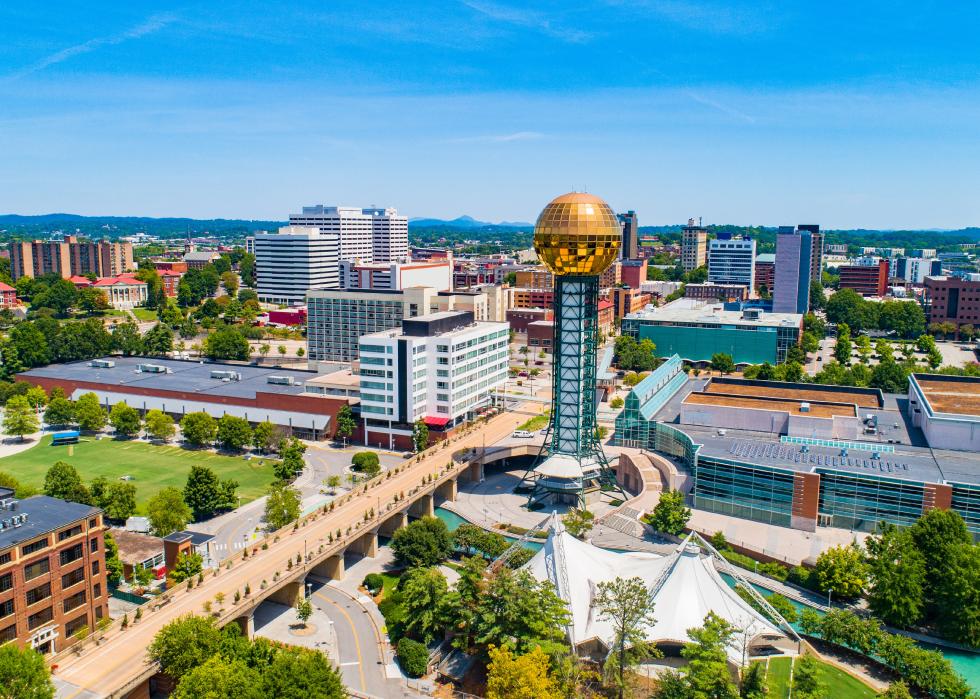
Tennessee
The federal government has announced $7.9 billion in funds toward Tennessee infrastructure projects. Here's how they break down:
- Transportation: 59.7% (Mostly in roads, bridges, and major projects)
- Clean energy, buildings, and manufacturing: 15.0%
- Broadband internet: 14.1%
- Clean water: 6.5%
- Resilience: 1.8%
- Environmental remediation: 1.5%
- Climate-smart agriculture: 0.3%
- Parks and conservation: 0.3%
- Other: 0.8%

Texas
The federal government has announced $35.0 billion in funds toward Texas infrastructure projects. Here's how they break down:
- Transportation: 59.9% (Mostly in roads, bridges, and major projects)
- Clean energy, buildings, and manufacturing: 16.7%
- Broadband internet: 13.1%
- Clean water: 4.5%
- Resilience: 3.6%
- Environmental remediation: 1.5%
- Climate-smart agriculture: 0.3%
- Parks and conservation: 0.2%
- Other: 0.2%
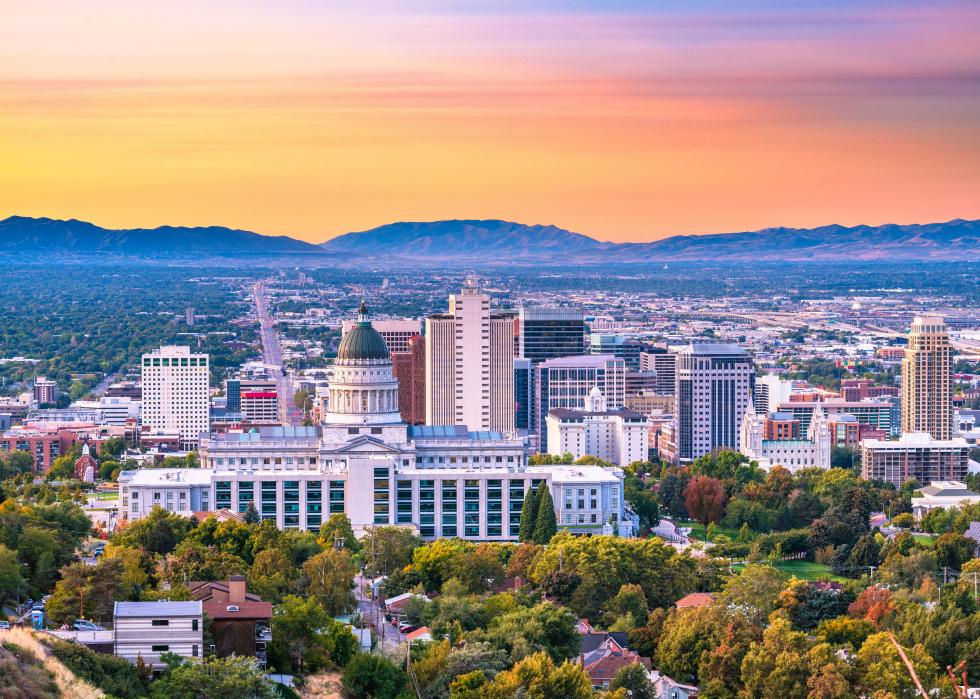
Utah
The federal government has announced $4.8 billion in funds toward Utah infrastructure projects. Here's how they break down:
- Transportation: 60.6% (Mostly in roads, bridges, and major projects)
- Clean energy, buildings, and manufacturing: 7.0%
- Broadband internet: 8.0%
- Clean water: 14.9%
- Resilience: 3.8%
- Environmental remediation: 3.0%
- Climate-smart agriculture: 0.9%
- Parks and conservation: 1.7%
- Other: 0.1%

Vermont
The federal government has announced $2.3 billion in funds toward Vermont infrastructure projects. Here's how they break down:
- Transportation: 50.7% (Mostly in roads, bridges, and major projects)
- Clean energy, buildings, and manufacturing: 12.7%
- Broadband internet: 10.8%
- Clean water: 10.0%
- Resilience: 3.7%
- Environmental remediation: 4.7%
- Climate-smart agriculture: 1.3%
- Parks and conservation: 0.4%
- Other: 5.8%
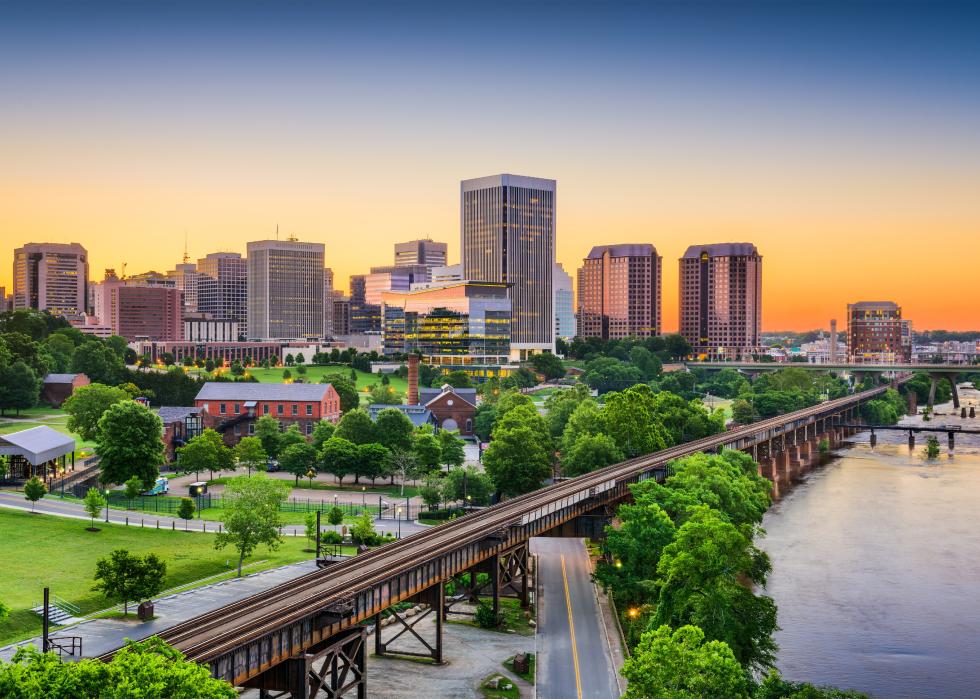
Virginia
The federal government has announced $11.2 billion in funds toward Virginia infrastructure projects. Here's how they break down:
- Transportation: 63.9% (Mostly in roads, bridges, and major projects)
- Clean energy, buildings, and manufacturing: 8.0%
- Broadband internet: 16.2%
- Clean water: 4.1%
- Resilience: 5.9%
- Environmental remediation: 1.2%
- Climate-smart agriculture: 0.2%
- Parks and conservation: 0.3%
- Other: 0.3%
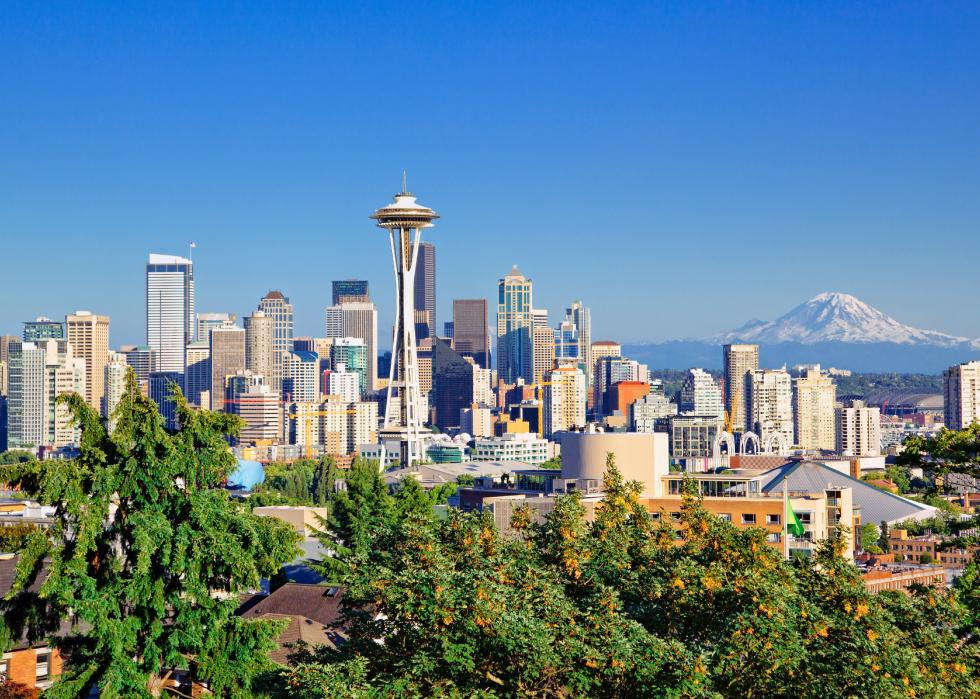
Washington
The federal government has announced $10.3 billion in funds toward Washington infrastructure projects. Here's how they break down:
- Transportation: 59.2% (Mostly in roads, bridges, and major projects)
- Clean energy, buildings, and manufacturing: 8.5%
- Broadband internet: 15.2%
- Clean water: 6.2%
- Resilience: 6.9%
- Environmental remediation: 1.5%
- Climate-smart agriculture: 0.2%
- Parks and conservation: 0.7%
- Other: 1.5%
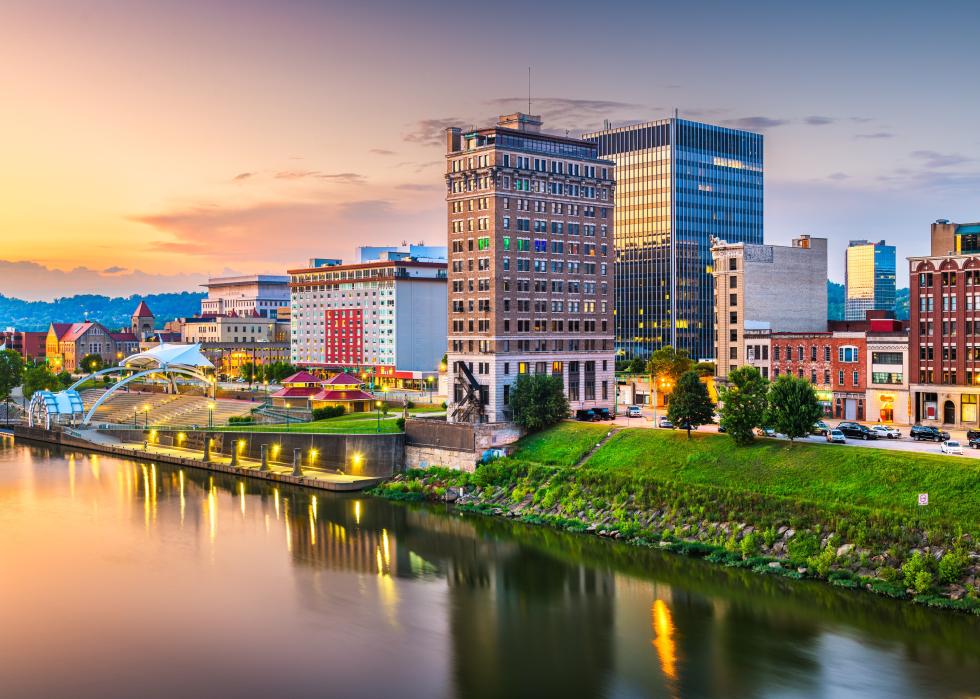
West Virginia
The federal government has announced $5.5 billion in funds toward West Virginia infrastructure projects. Here's how they break down:
- Transportation: 47.3% (Mostly in roads, bridges, and major projects)
- Clean energy, buildings, and manufacturing: 8.6%
- Broadband internet: 24.1%
- Clean water: 5.6%
- Resilience: 2.1%
- Environmental remediation: 11.5%
- Climate-smart agriculture: 0.0%
- Parks and conservation: 0.1%
- Other: 0.6%
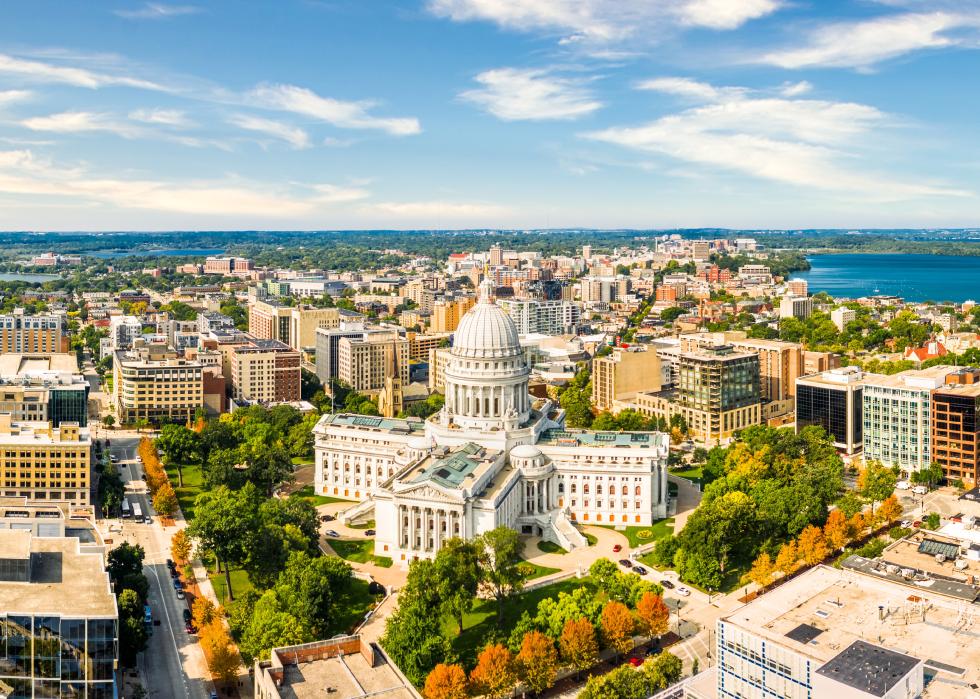
Wisconsin
The federal government has announced $7.2 billion in funds toward Wisconsin infrastructure projects. Here's how they break down:
- Transportation: 57.0% (Mostly in roads, bridges, and major projects)
- Clean energy, buildings, and manufacturing: 6.7%
- Broadband internet: 19.4%
- Clean water: 13.0%
- Resilience: 2.0%
- Environmental remediation: 1.0%
- Climate-smart agriculture: 0.4%
- Parks and conservation: 0.3%
- Other: 0.3%
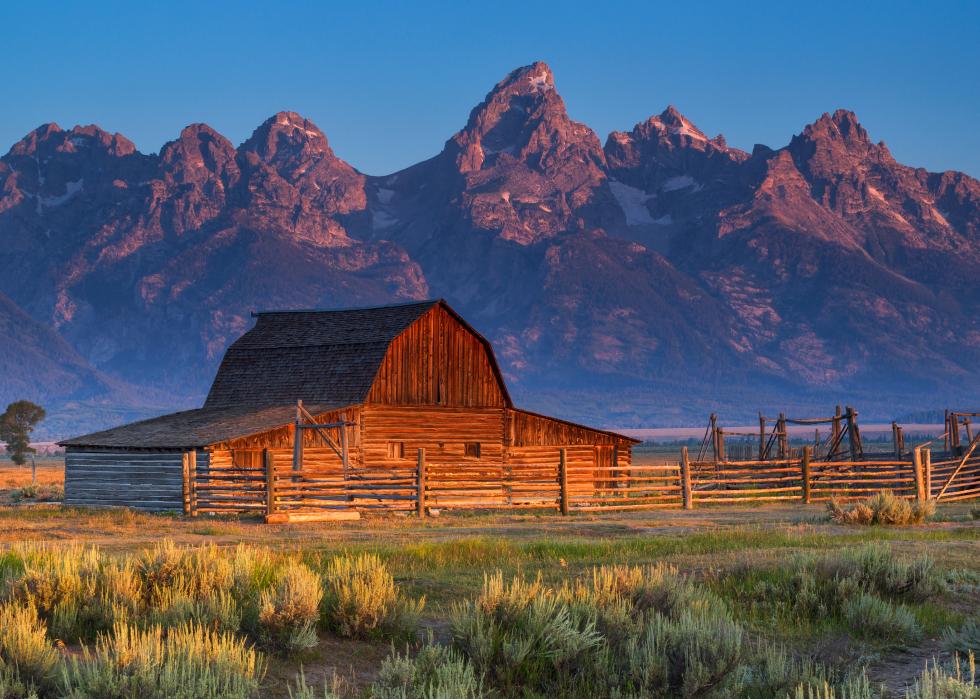
Wyoming
The federal government has announced $4.1 billion in funds toward Wyoming infrastructure projects. Here's how they break down:
- Transportation: 34.2% (Mostly in roads, bridges, and major projects)
- Clean energy, buildings, and manufacturing: 44.4%
- Broadband internet: 9.1%
- Clean water: 7.6%
- Resilience: 1.8%
- Environmental remediation: 2.1%
- Climate-smart agriculture: 0.1%
- Parks and conservation: 0.6%
- Other: 0.1%
Story editing by Alizah Salario. Additional editing by Kelly Glass. Copy editing by Tim Bruns.



